Ijraset Journal For Research in Applied Science and Engineering Technology
- Home / Ijraset
- On This Page
- Introduction
- Conclusion
- References
- Copyright
Revised Picture Articulation Test in Hindi
Authors: Himani Bansal, Dr. Satish Kumaraswamy
DOI Link: https://doi.org/10.22214/ijraset.2023.55148
Certificate: View Certificate
Abstract
Introduction
I. INTRODUCTION
Communication takes place when two or more organisms share information with each other. It is an inherent aspect observed in all living beings- no matter how different they are. Nonetheless, human beings have an exclusive privilege whereby we utilize arbitrary symbols for effective communication purposes. Verbal communication works by allowing speaker to send messages that listeners receive and interpret. The main aim of this whole process is essentially what we term 'communication'- transmitting knowledge and understanding between individuals.
Communication disorders carry considerable implications for individuals' social and emotional wellbeing, cognitive abilities, behavior and academic performance throughout their school years. They are potentially disabling conditions that can significantly impact their future career choices.
Speech is one way that language can be expressed, but it is particularly significant because it is the primary and first modality that users acquire. American Speech- Language- Hearing Association (ASHA, 1993) said that a geographical, social, cultural or ethnic variant of a symbol system should not be regarded as a speech or language impairment. The development of a child's overall language is closely tied to how well they learn different speech sounds (Bauman & Waengler, 2004).
For effective speech communication, articulation is a complex series of motions. Exact placement, timing, sequencing, direction and force of the articulators are necessary for accurate articulation. It is a series of overlapping ballistic movements that alters the outgoing air stream while simultaneously adding various levels of obstructions to its path (Nicolisi, Harrylmen and Krescheck, 1978).
Speech problems are most frequently characterized by errors in speech sound production. Mc Donald (1964) said that misarticulation is the generation of speech sounds that are insufficient for the acoustic representation of phonological sequences of a language or dialect. The inability to create speech sounds or their distorted creation are examples of articulation disorders (Kent & Read, 2001; Morgan & Gunther, 2017). The most typical sort of speech impairment is likely the problem in speech sound production. It should be possible for a speech language pathologist (SLP) to tell the normal population from the disordered group. The administration of suitable articulation tests can help achieve this.
When producing speech sounds, a child may make any of the following articulation errors: Substitution, Omission, Distortion or Addition. The articulation and phonological difficulties must be detected sooner and corrected quickly in order to prevent these issues. The SLPs should be able to recognize and distinguish persons with misarticulation from people with normal articulation in order to develop an effective rehabilitation plan. The choice of treatment for children will be based on a variety of variables including the child's age, speech sound mistakes, severity of the disorder and how much the disorder impacts overall intelligibility (Williams, McLeod & McCauley, 2010).
The results of an articulation test provide details regarding the types, quantities and traits of articulatory errors that people make when speaking. Finding the root cause and researching phonological development are both aided by it. A sequence of intricate activities is needed for normal articulation. Exact placement, timing, sequencing, direction and force of the articulators are necessary for accurate articulation. These take place concurrently with the precise modification of the air stream, the beginning or ending of phonation, and velopharyngeal activity.
In order to make their speech understandable, SLPs must screen and assess the population for speech sound abnormalities and identify them. This can be done by giving articulation tests, which can be used for interpretation, study, prediction, assessment and detection.
The Picture Articulation Test (PAT) is the most appropriate modality for testing articulation in children among the several methods used. PATs have been prepared in several Indian language including Kannada (Babu, Rathna and Betageri, 1972), Tamil (Usha & Karanth, 1986), Bengali (Banik & Barman, 1988), Hindi (Ruas, 1989), Telugu (Padmaja, 1989), Malayalam (Manoj, 1998), Konkani (D' Souza & Rao, 2001), Coorgie (Somanna & Varghese, 2007), Tulu (Parinitha & Prabhu, 2010) and Kashmiri (Shamiya & Kumaraswamy, 2019) and such attempts are made on regular basis.
Hindi is one of the most commonly spoken languages with more than 500 million speakers globally. However, the existing assessment tools in Hindi primarily focus on development of speech sounds up to a limited age group. They also do not assess many of the consonant and compound consonant sounds across initial, medial and final position in the words; limiting their applicability and accuracy within the Hindi-speaking population. Hence, the need arises for a comprehensive and standardized assessment tool in Hindi to cater to the unique linguistic characteristics and phonetic patterns of this population. The availability of a revised Picture Articulation Test in Hindi would enhance the accuracy of assessment of speech sound disorders in children and enable appropriate intervention planning, thereby improving therapeutic outcomes.
II. REVIEW OF LITERATURE
Mastery of the phonemic system is essential for a child's language development. The phonemes serve as the basic building blocks for the language's words which are therefore an important aspect of the grammatical system. The child recognizes the symbolic role of language, develops the rudiments of the grammar of his community's language and masters the phonemic system during the era of language acquisition which mainly includes the preschool and early school years. Speech is the vocal manifestation of language that connects meaning to sounds, which are called phonemes. Speech is the most exquisite and intricate serially ordered neuromotor behavior that humans are capable of producing. The generation of speech sounds is a complex process that requires precise planning, coordination and movement of several articulators. Clear speech results from proper articulation.
Speech Sound Disorders are the errors or difficulties with perception, motor production or phonological representation of speech sounds and speech segments and with the rules governing permissible speech sound sequences in a language (Bernthal & Bankson, 2017). Speech Sound Disorder is the umbrella term, it refers to any combination of difficulties with perception, motor production and/or the phonological representation of speech sounds and speech segments (including phonotactic rules that govern syllable shape, structure and stress as well as prosody) that impact speech intelligibility (Randolph, 2017). Sound or speech disorders are the disorders of communication in which the normal sound and speech is impaired. This can result into number of further disorders.
ASHA (2004) says that clinical indications for a speech sound assessment are initiated by referral (from a health or an education professional), the client’s medical status or by failing a speech language screening. Assessment is the procedure by which the clinician measures the individual’s disorder. It can be divided into two phases: appraisal and diagnosis (Darley, 1991). Appraisal refers to the collection of data, while the diagnosis represents the end results of studying and interpreting these data. Effective assessments are essential for clinical procedures. They lead us through the entire diagnostic and therapeutic purposes.
Articulation testing is a procedure using which the phonemic producing ability of an individual can be determined. Articulation test helps in:
- Identifying client with abnormal articulation.
- Locating possible causative factors.
- Studying phonological development.
- Deciding the necessity of therapy.
- Planning and evaluating therapy.
- Finding out the effectiveness of therapy.
- Describing phonemic ability of an individual.
- Locating the sounds that should be treated first during therapy.
- Predicting the improvement of therapy.
- Comparing the effect of particular environment and kind of stimulation.
The testing of articulation, premises underlying testing and the interpretation of test results have gone through a number of changes due to the arrival of dominant theories over time. In the fifties (Templin, 1957), phonemes were treated as minimal elements that were mastered sequentially as a function of age and motor skill. Age of acquisition norms were a reflection of this sequential learning of phonemes as the child matured.
Articulation tests have various purposes:
a. To set up norms for the normal development of phonology.
b. To determine phonetic proficiency.
c. Predicting the improvement of articulation therapy.
d. For the purpose of screening.
e. To scrutinize the speech of a child and to determine the nature of deviancy.
f. To check if a child is developing normally in terms of phonology using normal phonological processes.
g. To identify the articulatory errors that makes the speech acoustically unacceptable.
h. To determine the casual factors that initiates the articulation problems or contributes to its severity.
A. Traditional Investigations of Speech Sound Development in Children
The traditional studies of the chronological development of speech sounds in children are those by Wellman, Case, Manget & Bradburg (1931). They tested 204 children of ages 2 to 6 years. Sounds were assessed in initial, medial and final positions in words produced spontaneously or by imitation. A sound was assigned for an age level only if 75% of that age children produced it correctly in all three positions in words.
Poole (1934) investigated the speech sound development in two and half to eight and half years in 140 children. Sounds were assessed in initial, medial and final positions and were produced spontaneously or by imitation. Criterion for mastery of a speech sound was correct production by all subjects at particular age level.
Templin (1957) carried out research on 480 children of age 3 to 8 years. Speech sounds were assessed in all the 3 positions and 75% criteria was kept for the mastery of sounds for every ages.
Investigation of speech sound development in children includes those conducted by Prather, Hedrick & Kern (1975), Arlt & Goodban (1976) and Wright (1969). Prather, Hedrick & Kern (1975) reported articulation data from the normative study for the SICD (Sequential Inventory of Communication Development) in which articulation development of 147 children of ages two to four years were examined. Speech sounds were assessed in the initial and final position only and were elicited by spontaneous production and imitation. Mastery of a speech sound at particular age level was determined by the 75% criterion. Arlt & Goodban (1976) investigated speech sound development of 3 to 6 years in 240 children, 79 sound elements were elicited by imitation including 22 consonant elements in initial position, 20 in medial position, 20 in final position, 6 double consonant blends, 7 vowels and 4 diphthongs. Criterion for mastery of speech sound was set up at 75%.
Weybright (1976) studied the development of 2 consonants (/t/ & /k/) in speech of children of ages 3 to 6 years. In all the 3 positions the target sounds were assigned. 75% mastery criterion was used to assign ages.
Evidences presented by Prather et al (1975), Arlt & Goodban (1976) and Weybright (1976) suggests that children are learning speech sounds at younger ages.
Kim, Pae & Lee (2005) did a study for the development of the ‘Test of Articulation for Children’. The purpose of this study was to develop the ‘Test of Articulation for Children (TAC)’ that measures articulatory and phonological development for children and to examine its concurrent validity. 'TAC' investigates 70 speech sounds. These items were selected by examining the characteristics, development and frequency of Korean consonants in order to test the 19 Korean consonants in various phonetic contexts. A total of 70 speech sounds were elicited through 37 words that preschool children could spontaneously produce. Thirty normal developing children from the age of 3 to 5 participated in the concurrent validity test. They compared the percentage of consonants correct (PCC) of ‘TAC’ with that of the ‘picture articulation test’ and the spontaneous speech. The Pearson’s correlation coefficient was .92 with the PCC of the ‘picture articulation test’, and .91 with the PCC of spontaneous speech. In addition, the PCCs of plosives, nasals, affricates, liquids, and fricatives of ‘TAC’ had statistically significant correlations with those of the spontaneous speech. This result showed that ‘TAC’ is a valid tool in diagnosing children with articulatory and phonological disorders, and that it could become a useful tool in the application to spontaneous speech.
Kaur & Rau (2015) did a descriptive analysis of phonological development in typically developing Hindi-speaking children. It was noted in the results that children’s speech becomes more accurate as they get older. They articulate more sounds correctly and use fewer error patterns. Analyzing performance in six monthly age bands revealed a gradual progression of speech accuracy. Significant differences were identified between groups of children aged 4.0-4.5 years; 4.5-5.0 years; 5.0-5.5 years and 5.5–6.0 years. Differences were found between the four age groups on the Mean Scores of phonemes acquired and Percentage of children using the phonemes accurately. The percentage of consonants and sounds that the children produced correctly was noted along with the position (initial, medial and final) in which various sounds were produced accurately. The accuracy of sounds increased with age. The two younger groups differed from the two older groups on the percentage of sounds they produced correctly. Ceiling effects were noted which means that the two older age groups did not differ much on sound accuracy. Moreover, it is noted that the acquisition of vowels gets completed by the age of four. However, few long vowels (/o:/, /e/) as well as complex diphthongs (/iu/, /ua:n/, /ai/) continued to develop until the age of five.
Pyata & Banik (2016) studied the phonological development profile in typically developing Hindi speaking children. The study aimed to delineate the phonological development across 2 ½ to 6 ½ years of typically developing Hindi speaking children. A total of 80 children from Mumbai who were further sub divided into 4 groups i.e., 2 ½ - 3 ½ years, 3 ½ -4 ½ years, 4 ½ -5 ½ years and 5 ½ - 6 ½ years with each group constituting 10 females and 10 males participated in the study. The inclusion criteria for the children were native Hindi speaking with normal oral peripheral mechanism, attending Hindi medium school and with no associated problems. The Photo articulation test in Hindi was administered on all the children. A total of 16 vowels, 30 consonants and 11 blends were assessed. Th responses were recorded using Sony digital audio recorder and further transcribed in broad IPA by the researcher. A phoneme acquisition criterion of 80% and above was selected for all the phonemes to be considered as acquired. The data was subjected to descriptive statistical analysis to identify mean and standard deviation values and further the mean scores were converted into percentages. The results indicated a clear correlation between the features of the phonemes and their age of acquisition.
Noveen, Butt & Alam (2017) did a study on the development of a test for articulation and phonological disorders in Urdu speaking children. The objective of the test was to develop a valid and reliable tool for assessment of Urdu Articulation and Phonological Disorders in children (TAAPU) between 4-8 years of age. The study employed a cross sectional study design. Validity and reliability assessments were conducted for the development of the test. TAAPU was piloted and developed in Islamabad and Rawalpindi using purposive sampling technique for primary data collection; a sample of 50 children without APD and sample of 50 children with suspected speech sound disorder were included. Statistical Package for Social Sciences (SPSS- Version 21.0) was used in the study. The study concluded that TAAPU was a valid and reliable tool for assessment of APD for Urdu speaking children.
Kim, Park, Kang, Shin & Ha (2018) studied validity and reliability analyses for the development of Urimal Test of Articulation and Phonology-2 (U-TAP2). U-TAP2 has been developed to assess 2- to 7-year-old children’s phonological ability. U-TAP2 consists of two levels: word and sentence. Six hundred and sixteen children participated in this study. For content validity, a 5-score-scale was used for each item and speech-language pathologists served as assessors. The correlations among measured variables—U-TAP percentage of correct consonants (PCC), phonological mean length of utterance (PMLU), proportion of whole-word proximity (PWP), proportion of whole-word correctness (PWC)—were analyzed for construct validity. The results of this study indicated that the U-TAP2 is a valid and reliable assessment tool for children’s phonological ability and that it can provide useful information in analyzing the developmental characteristics of phonological abilities and in intervening the children who have phonological problems.
Articulation testing is most successful in settings in which clients do not show a high incidence of articulation and phonological problems including well baby clinics, preschool and grade schools.
B. Factors Affecting Articulation Testing
Recent studies have shown that articulation testing procedure and test environment have substantial influence on test results.
Screening and complete evaluation should be done in a room sufficient quiet to hear speech. Room should be clean and there should not be any disturbances but not sterile. When testing younger children, toys and other play things should be absent from their vicinity. If possible, have parents or caregivers familiar with the client. If a client has physical limitation or special motoric needs, positioning should be undertaken with guidance from occupational or physical therapist (Bleile & Miller, 1994).
If the client has a medical condition, a nurse or other qualified staff member knowledgeable about client's medical status should be consulted to rule out the existence of medical complications that would either interfere with assessment or exacerbate the client's medical problems (Bleile & Miller, 1994).
C. Classification of Articulation Tests
Articulation tests can be broadly classified into informal and formal tests. Formal tests can be again classified as developmental, screening, predictive, diagnostic and deep tests.
- Informal Tests
Since conversation is final criterion by which we judge articulation proficiency, we should have some type of measure for sampling a client's misarticulations through his conversation. Spontaneous connected speech provides many different phonetic contexts and requires rapid co- articulation in its ongoing adjustments and changing tension.
a. Advantages
- It tests the production of sound in a natural situation
- It tests the co- articulation effect.
b. Disadvantages
- The clients may not use words containing all phonemes that are to be assessed. It is time consuming. The clinician may be unable to analyze all the errors in the client's free speech. Some children may be reluctant to engage in conversational dialogue with an unknown adult.
- Speech of individual with severe misarticulation are bound to be most unintelligible, thus it may not be possible to determine what they are attempting to say in conversational speech.
2. Formal Tests
There are five different types of formal articulation tests, which include developmental, screening, diagnostic, predictive and deep tests. Although there are important commonalities among persons with articulation disorders and among the disorders themselves, there are also important differences that must be considered when appropriate tests are being selected. These include age, sex, degree of severity of disorder, purpose of referral, need of client, causal pattern of disorder, concerns of family, personality and attitude of client, level of intellectual functioning, motor co- ordination and educational, emotional and environmental factors. The rationale underlying test selection and other procedures must always be kept in mind. These selections will be based partly on client characteristics such as: length, standardization, thoroughness, ease of administration, appropriateness, client appeal and cost.
3. Developmental Tests of Articulation
This procedure examines a child's articulation of several sounds and then evaluates the developmental status of each of individual sound tested. This is done by noting the age at which the child's defective sounds are matured by children of normative study. When a child has not learned to produce a certain sound that is utters correctly by his peers, the sound is considered to be defective in articulation. The Hejna developmental articulation test is one like this. The test contains 25 items which assess phonemes in three positions in words. Sounds are listed in developmental order accordingly as the age at which the child masters them.
4. Screening Tests of Articulation
Purpose is to identify persons, who may have an articulation disorder, but not to describe it or make a diagnosis. The procedures are sometimes informal though formal tests are available. The aim is to detect those persons having defective articulation as quickly as possible such as entire class rooms of school populations. Templin - Darley test has 50 items which may be used for screening. Winitz (1969) criticized it by saying that it provides only statistical norm to sort out children with deviant articulation. But Irwin (1972) points out that it is only an event to further testing. Mc Donald's screening test is made of the most frequently misarticulated sounds, but only the voiceless ones of cognate pairs. Such a test neglects those sounds on which child may make voicing errors. The Kannada screening articulation test was devised by Babu, Rathna & Betageri (1972). The test consists of 54 cards each carrying a picture. Each picture elicits one sound or one blend, each in one position. Only selected phonemes were tested in this test. Vowels were not tested as they are generally uttered correctly by the end of the second year. A passage including all the phonemes of Kannada (except the aspirated ones) is included in the test.
Winifr (1969) suggests that results of screening test along with the following criteria make it more meaningful:
- Level of developmental achievement of phoneme contrast.
- Level of articulatory performance necessary for beginning school.
- Parental concern, if any.
- Knowledge as to whether the child will correct himself.
a. Advantages
- It is less time consuming.
- It can detect an articulation disorder in an individual or group situation.
- It can also be used in camps to screen large populations.
- It can be used in school screening programs where articulatory disorders can be identified.
b. Disadvantages
- They do not describe or diagnose the problem.
- They do not contain all the sounds in the language.
- It does not test spontaneous speech.
5. Predictive Tests of Articulation
One function of an articulation test is prediction, to determine those children who will or will not retain their early articulation errors. It gives a gross measure of the individuals' articulatory abilities, to determine if further testing and intervention is warranted. The general procedure employed in studies designed to perform this function involves the selection of:
- Age — levels and interval over which the prediction is to be made.
- Measures to be used as predictive variables.
- Articulatory tests which will measure improvement at the end of test interval.
A variety of measures have been selected as potentially predictive. Included are such measures as number of articulatory errors or when stimulated with the correct production of the sound, the ability to learn other sounds and performances on speech sound discrimination tests.
Irwin, West & Trombetta (1966) found that the number of sounds misarticulated has predictive value. Farquhar (1961) discovered that the articulatory discrimination skills of nursery kids did not predict their articulation development.
Arndt, Elbert & Shelton (1971) used the degree of improvement during first through therapy sessions as a measure of prediction of progress over 15 therapy sessions.
The basic principle of Predictive Screening test of Articulation (PSTA) is to differentiate children who will master their misarticulations without speech therapy from those who, without therapy, may persist in their problem even by the time they reach Ill grade level. PSTA is administered to children at the I grade level. A cut off score of 39 was decided for this test.
However, Winitz (1975) comments that Predictive articulation tests predict and diagnose poorly. He says that the only reliable function is of assessing phonetic proficiency, the results of which are used to index incorrect sound production.
a. Advantages
- It is not time consuming.
- It helps in deciding whether therapy is required.
- Helps in predicting the prognosis of the client.
b. Disadvantages
- It does not test spontaneous speech.
- It does not test a found in different contexts.
6. Diagnostic Tests of Articulation
These tests are designed to identify defective speech sounds and to what extent they are affected. Such a test may be used in deciding whether a child needs speech correction or not but frequently it is used with children already identified as articulatory problems to aid in prescribing the nature of speech correction. It provides detailed information about child's ability to produce a wide range of speech sounds in a variety of positions and phonetic contexts.
E.g.: Articulation test in Telugu contains 283 words. It tests consonants, vowels and blends in initial, medial and final positions, which in turn helps in thorough examination of the articulation defect and also helps in finding out the place of misarticulation. There are also 80 items for phonemic discrimination testing.
a. Advantages
- It helps the clinician obtain a representative sample within a short period of time.
- It tests phonemes in different word positions.
b. Disadvantages:
- It is unable to evaluate the effect of co — articulation on speech productions.
7. Deep Test of Articulation
Deep test of articulation given by Mc Donald (1964) permits evaluation of speech sounds as the audible end products of series of overlapping, ballistic movement.
It samples representatively the phonetic contexts in which the sound being observed might occur and provides a test, long enough to permit observation of the degree of variability present in the speaker's production of the sound. A picture form, a sentence form and a screening form for this test are available.
The rationale for this test was derived from Stetson (1951) who stated that the accurate possible positions for phonemes to occur are as the releasing and arresting sounds at the beginning and endings of the breath phrases respectively. Mc Donald (1964) devised the deep test so that each test phoneme can be assessed either preceding or following every other possible phoneme. Mc Donald's theory holds that a speaker can achieve correct articulation more easily when the test phoneme is presented in a constant blend than when it is presented in isolation. The picture form test is used with persons whose reading ability is below third grade level. For those at or above third grade, the sentence deep test is used. The recording sheet provides blanks for recording types of misarticulations and correct or incorrect articulation of the sounds tested. The progression continuum for any sound from almost be never correct to almost always correct permits on the evaluation of therapy. This test is widely accepted.
Maya (1990) developed deep test of articulation (sentence form) in Malayalam. She used eight key phonemes which were frequently misarticulated by children. Simple meaningful sentences were used. The sentence length was 2-3 words with these target phonemes tested in vowels- consonant and consonant-cluster environment. The test consists of 87 sentences including 27 sentences in which the target phonemes were tested in cluster environment. 70 Malayalam speaking children in the age range of 5-8 years were tested. She reported a maximum score of 95.86% at 7-8 years. There was an increase in the total score with the increase of age and /s/ & /S/ were most difficult items to articulate in all the age groups. She also found that /s/ was acquired by Malayalam speaking children only by 5-5.6 years, /r/ by 4.6-5 years and /s/ by 4-4.6 years. She also opined that this could be the reason why children had difficulty in producing /S/ correctly in the deep test of articulation.
a. Advantage
- The test provides information for distinctive feature analysis of articulation.
- They identify correct productions that are valuable starting points for therapy.
b. Disadvantage
- It is very long and laborious.
- Valid results are obtained only for certain speech problem.
- Slow speaking children and children who have difficulty in blending due to multiple misarticulating, pose to be a problem in using the test.
D. Published Assessment Instruments
Table 2.1:
Showing Standardized Diagnostic Test Materials for Speech Sound Disorders
|
Name of the Protocol |
Author & Year |
Description of the Test Protocols |
||
|
The Hudson Assessment of Phonological Patterns 3rd Edition |
Hudson, B. Barbara, William Hudson, 1986 |
Norm-referenced and also criterion referenced. The HAPP-3, as well as its predecessors (APP, 1980; APP- |
Ages 3-0 to 8-0. Testing Time 15-20 minutes (comprehensive), 2-5 minutes (screening) |
Objects and a few pictures are used to elicit 50 stimulus words. |
|
Assessment Link between Phonology and Articulation (ALPHA) |
Robert J. Lowe, 1986 |
The 15 phonological processes evaluated by the ALPHA are listed below: Consonant Deletion Backing |
3 years old and above |
The ALPHA provides two assessments using a delayed sentence imitation format. ALPHA provides a traditional sound-in position assessment looking at initial and final consonant production. S 50 target words are embedded in a short sentence. ALPHA examines consonants that occur in the Initial and final positions of syllables, and does not directly address medial position consonants. |
|
Bank- Bernthal Test of Phonology |
Bankson & Bernthal, 1990 |
Age range: 3-9 years |
Administered in 15-20 minutes |
It checks: a whole word accuracy analysis; a traditional consonant articulation analysis; and a phonological process analysis. |
|
A Deep Test of Articulation |
Mc Donald, 1964 |
3-12 years. Contextual test for individual phonemes. |
Administered in 15-20 minutes |
It permits evaluation of speech sounds as the audible end product of series of overlapping, ballistic movements. |
|
Spanish Articulation Measures (SAM) |
Mattis, L. 1993 |
Ages 3 years and above |
SAM is comprised of four measures that assess 18 Spanish consonants |
Assess acquisition of individual sound elimination of error patterns in Spanish speaking children |
|
Templin- Darley Tests of Articulation |
Templin, M. and Darley, F. 1986 |
Tests of individual sounds for late pre-schooler and school- age children. |
Administered in 1 hour. |
Assess sound errors for late pre-schooler and school - age children |
|
Test of Minimal Articulation Competence (T-MAC) |
Secord, W. 1981 |
Test of individual sound, requires approximately 10-20 minutes to complete |
||
|
Test of Phonological Awareness (TOPA) |
Torgesen, J. & Bryant, B. 1994 |
Test of a child's awareness of individual sounds in words |
||
|
Weiss Comprehensive Articulation Test (WCAT) |
Wiss, C. 1980 |
Test for pre-schoolers to adults |
||
|
Pre-school Language Scale 5th Edition (PLS-5)- Articulation Screener |
Irla Lee Zimmerman, Violette G. Steiner & Roberta Evatt Pond, 2011 |
Age range: birth-6.11 years, Administration time: 5 minutes |
Language(s): English, Spanish |
|
|
Diagnostic Evaluation of Articulation and Phonology (DEAP) |
Barbara Dodd & Zhu Hua, 2002 |
Age range: 3.0-6.11 years |
Administration: Individual - 5 minutes screen plus up to 4 specific assessments Five tests (two screens and three assessments) comprise the DEAP assessment process. |
Detects and differentiates between articulation problems, delayed phonology and consistent versus inconsistent phonological disorder |
E. Method of Constructing Articulation Test
Tests are systematic procedures that yield a score. The procedures are standardized in terms of administration and scoring and they yield a score that allows interpretation of the performance of the individual tested. Tests are objective and therefore may be of more value than subjective impressions.
1. Process Of Test Development
Test development can be broken down into three different stages:
a. Construction: Here issues such as item writing, material selection, response Sets, scale construction and selection of test formation are of primary interest.
b. Standardization: New tests are standardized for the use on a particular target population. The sample chosen should be a general population. Norms are developed and considerable research is undertaken to establish the estimate of the test reliability and validity.
c. Revision: Tests are revised to keep them contemporary and current, both with respect to norms available and item context.
In order to construct a test, one has to decide the following:
- Type of Tests: Whether it's a screening, predictive, diagnostic or deep test.
- Test material selection: The following factors have to be kept in mind for selecting material for the test. It should be appropriate for the population under study and should consider the developmental age of the population under study.
2. Articulation Samples
a. Spontaneous Speech: A standard procedure in the assessment battery is to evaluate the sound production in running speech. Sample elicitation is by spontaneous conversation, reading or repetition.
Advantages
- Spontaneous speech sample helps in the evaluation of co — articulatory effects in speech.
Disadvantages
- The child may not be co — operative to speak and so it may be difficult to elicit a connected speech sample.
- Children with delayed or deviant language will not be able to be assessed.
b. Sound inventories: Here the client names or reads single words in elicit a connected speech sample.
Advantages
- These are quick ways of articulatory evaluation and children may be co — operative with such type of inventories.
Disadvantages:
- It doesn't assess speech in natural situation.
- It doesn't test the effect of co- articulation.
3. Method of Recording Responses
According to van Riper and Irwin (1968) the result of the examination can be described under 3 headings:
a. General impression
b. Specific sounds: Defective phoneme/ type of defect.
- Type of Defect: It can be distortion, substitution, omission and addition.
- Test situation: The rapport with the client and the test environment.
- Position in the word: Whether the sound misarticulated is in initial or medial or final position.
c. Variability of Definite productions
In a simple way, the responses can be scored as correct or incorrect based on examiner's perception of whether the sound produced is within the socially acceptable phoneme boundary for a particular linguistic context.
F. Methods of Analysis
- Pattern analysis: The purpose of pattern analysis is to discover the organization underlying the sound errors within the child's phonological repertoire. It offers insight into the relationship among sound segments and the interaction between speech articulation and higher levels of linguistic organization. The number of segments in error may influence the direction of treatment program.
- Kinetic analysis: In this method misarticulated sounds are reviewed to determine whether similarities exist in terms of their voicing, manner of production and place of articulation. This facilitated the identification of patterns such as voice for voiceless, sound substitutions, replacement of lingua-velar sounds by lingua-alveolar sounds.
- Phonological Process analysis: (Compton - 1975, Wiener — 1978, Mc Reyholds & Elbert — 1978, Hodson — 1980, Shriberg & Kwiathowski — 1980). Phonological processes are suppressed and modified as the child matures and its phonological system closely approximate the adult standard. These processes affect words differently over time. In simple words phonological process may be defines as the pattern of sound use that are modifications or simplifications of adult phonology.
Ingram (1976) classified phonological processes under following categories:
a. Syllable structure processes — common in early stages of development.
- Final consonant deletion. E.g.: dad- da
- Deletion of unstressed syllables in multisyllabic word. E.g.: pyjamas - jamas.
- Syllabic structures are reduplicated. E.g.: baba for bottle.
b. Cluster reduction: These are retained by the child for long time.
- Deletion of entire cluster. E.g.: ey for play.
- Use of cluster for substitution for one phoneme. E.g.: play for pay.
c. Assimilation Process: These are instances where one sound segment affects or influences the production of other sound. Assimilation process can be of two types- progressive and regressive.
Bernthal & Bankson (cited in Mc Reyholds & Elbert, 1978): categorized phonological processes into two;
- Whole word processes: which operate to simplify word or syllable structure.
- Segment process: which involves some form of substitution for specific segment or type of segment.
4. Natural Process Analysis: Shriberg and Kwiathowski (1980) used only following eight natural processes in their analysis.
a. Final consonant deletion
b. Velar fronting
c. Stopping
d. Palatal fronting
e. Liquid simplification
f. Assimilation
g. Cluster reduction
h. Unstressed syllable deletion
They base their choice of natural processes on these factors.
a. No process must have phonological reality based on the fact that
- it changes a more complex one and
- it occurs across languages.
b. It must be frequently occurring in children with delayed speech.
c. It must be able to score reliably by children.
5. Distinctive Feature analysis: Distinctive Feature systems are binary systems which describe a feature as being either present or absent. Fisher and Logeman (1971) incorporated a distinctive feature analysis into their test format. According to Pollack and Rees (1972) it provides a measure of the severity of the defect.
G. Organizing Articulation Test Results
Describing the error: To describe errors there are at least two different scoring systems (Shiberg and Kent, 2003). The following scoring systems are available-
a. Two- way Scoring
A choice is made between a production that is 'right' (accurate articulation of sound) and 'wrong' (inaccurate articulation). Two- way scoring can be used effectively to give feedback to client and to document therapy progress. It can also be used in a screening protocol.
b. Four- way Scoring
This system uses a classification based on type of error. 'Correct; or 'norm productions', constitute one category. The other four categories are-
- Deletion or omission- a sound is deleted completely;
- Substitution- a sound is replaced by another sound;
- Distortion- the target sound is approximated but not closely enough to be considered a norm realization;
- Addition- a sound or sounds are added to the intended sound.
Certain error types have been found to occur more frequently in spontaneous conversations than in naming; these include cluster reduction, final consonant and initial consonant deletion, syllable deletion, assimilation, coalescence, neutralization and stopping (Andrews & Fey, 1986; Dubois & Bernthal, 1978; Dyson & Robinson, 1987; Healy & Madison, 1987; Klein, 1984; Paden & Moss, 1985; Paynter & Sims, 1979).
H. Articulation Testing in Indian Languages
As every language has its own phonological system, articulation tests are language specific. Therefore, in a multi- lingual country like India, there needs to be articulation tests in all languages. Currently Diagnostic Picture Articulation Tests are available only in-
- Kannada (Babu, Rathna and Betageri, 1972)
- Tamil (Usha & Karanth, 1986)
- Bengali (Banik & Barman, 1988)
- Hindi (Ruas, 1989)
- Telugu (Padmaja, 1989)
- Malayalam (Manoj, 1998)
- Konkani (D’ Souza & Rao, 2001)
- Coorgie (Somanna & Varghese, 2007)
- Tulu (Parinitha & Prabhu, 2010)
- Kashmiri (Shamiya & Kumaraswamy, 2019)
Table 2.2:
Showing Picture Articulation Tests available in Indian languages
|
Name of the Study |
Author |
Year |
Description of the Study Findings |
|
|
Kannada Picture Articulation Test |
Babu, Rathna & Betageri |
1972 |
112 items in three parts. Part I: Vowels, diphthongs and consonants. Part II: Same as I but sounds are tested in different words. Part III tests blends. |
/p/, /b/, /m/, /t?/, /d?/, /n/, /k/, /g/, /t/, /j/ and /I/ sounds are acquired before 3 years. /t?/ is acquired at 4 and /d/ and /?/ are acquired at the age of 4 and half years. /l/, /s/ & /r/ are acquired at 5 years and /?/ is acquired at 6 years. |
|
Tamil Picture Articulation Test |
Usha & Karanth |
1986 |
Black & white line drawing is used and picture has to be named by the individual. Tests children from 3 years and above. |
/p/, /b/, /m/, /t?/, /d?/ & /n/ sounds are acquired before 3 years of age. /t?/ is acquired at 4 and half. /s/, /r/, /t/, /j/ & /l/ are seen to be acquired at the age of 5 and half years. |
|
Picture Articulation Test in Bengali |
Banik & Barman |
1988 |
Administered for 3-8 years of age. |
/m/, /t?/, /d?/ & /n/ are acquired before 3 years. /p/, /b/, /?/ & /r/ at 4 years. /k/ & /g/ at 4 and half years. /s/, /t/, /j/ & /?/ are acquired at 5 years. /l/ is seen to be acquired at 5 and half years. |
|
Picture Articulation Test in Hindi |
Ruas |
1989 |
Administered for 3 years and above. |
/?/ is acquired as early as 3 and half years. /m/, /t?/, /d?/ & /n/ before 3 years. /p/, /?/ & /r/ at 4, /k/, /g/, /t?/ & /l/ at 4 and half years. /s/, /t/, /j/ & /l/ at 5 years. |
|
Picture Articulation Test in Malayalam |
Manoj |
1998 |
Administered for 3-8 years of age. |
/p/, /b/, /m/, /t?/, /d?/, /n/, /k/, /g/, /t/, /d/, /t?/, /?/ & /?/ are acquired before 3 years of age. /s/ & /I/ acquired at 4 and half and /r/, /l/ & /j/ at 5 years of age |
|
Picture Articulation Test in Konkani |
D' Souza & Rao |
2001 |
Administered for 3-8 years of age. |
/p/, /b/, /m/, /t?/, /d?/, /t/ & /d/ are acquired before 3 years. /k/, /g/ /I/ & /j/ were achieved at 3 and half years. /?/ at 4, /s/ at 4 and half. /l/ at 5, /?/ by 5 and half and /t?/ was achieved by 7 and half years. |
|
Picture Articulation Test in Coorgie |
Somanna & Varghese |
2007 |
Administered for 3-7 years of age. |
/p/, /b/, /m/, /t?/, /d?/, /n/, /k/, /g/, /t/, /d/ & /?/ are achieved before 3 years of age. /s/, /r/, /t?/, /?/, /l/ & /j/ at 3 and half years. |
|
Picture Articulation Test in Tulu |
Parinitha & Prabhu |
2010 |
Administered for 3-8 years of age. |
/p/, /b/, /m/, /t?/, /d?/, /n/, /k/, /g/, /t/, /d/, /t?/, /?/ & /?/ are acquired before 3 years of age. /r/ by 4 and half years and /l/ is achieved by 5 and half years. |
|
Picture Articulation Test in Kashmiri |
Shamiya & Kumaraswamy |
2019 |
Administered for 3-8 years of age. |
/p/, /b/, /n/, /m/ & /p?/ are acquired by 3 years. /k/, /g/, /h/, /j/, /k?/ & /d?/ by 4 years, /z/ & /v/ by 5 years and /s/, /r/, /l/, /t?/, /?/ & /t??/ are achieved by 51/2-6 years of age |
I. Attributes of a Good Test
a. It is portable and easily manipulated.
b. Pictures are attractive, easily identifiable and culture free.
c. Tests all phonemes singly in all contexts.
d. Provides for pattern analysis.
e. Includes stimulability procedure.
f. Supplies adequate normative data.
g. Allows reliable quantification of results.
h. Prescribes single scoring system that facilitates interest reliability.
i. Contains material for eliciting spontaneous natural speech.
From the review of literature, it is evident that articulation tests are important for assessment and moreover it gives a quantitative information about which is useful for making comparisons among children being tested, as well as for pre and post treatment within subject comparison.
J. Need For This Study
In a multi-lingual country like India, there is a need for articulation tests in various languages. The present study on ‘Revised Picture Articulation Test in Hindi’ holds significant implications for the field of Speech-Language Pathology. It addresses the pressing need for a culturally appropriate, reliable, and valid assessment tool for speech sound disorders within the Hindi-speaking population. The study's outcomes will contribute to enhancing diagnostic accuracy, facilitating research and improving intervention strategies for individuals with speech sound disorders in Hindi.
III. METHODOLOGY
A. Aim Of The Study
The aim of the present study is to revise the Picture Articulation Test for typical children speaking Hindi with following objectives:
- Documentation of normative data, including error patterns and speech sound acquisition milestones in the typical children speaking hindi.
- Comparison of the revised test results with existing assessment tools to establish its effectiveness.
Procedure: The study was done in two parts.
- Part 1: Construction of the test
- Part 2: Establishment of test norms
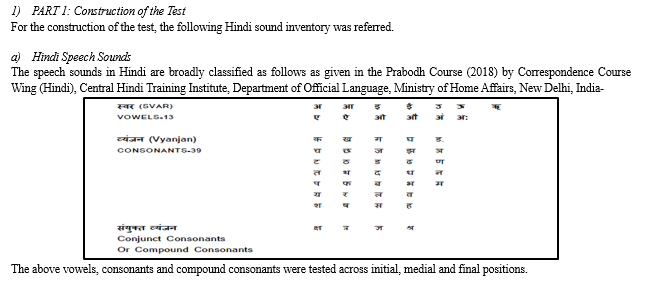
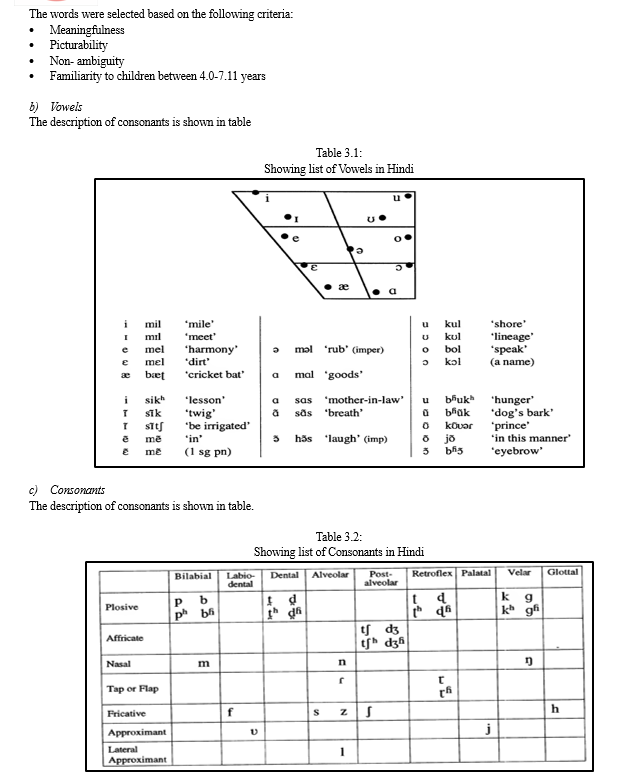
The Final Test Material:
The articulation test material was constructed in Hindi in the following three sections.
- Section I: 6 vowels were tested in initial, medial and final positions except for /i/, /æ?/, /o:/, /??/ & /??/.
These phonemes could not be tested in all word positions due to the following reasons-
- Lack or absence of existence of Hindi words with the sound in the required positions.
- Did not satisfy the picture selection criteria for the children between 4.0-7.11 years.
Therefore, /i/, /o:/, /??/ & /??/ were tested in initial and medial position and /æ?/ could be tested in only initial position.
- Section II: 24 consonants were tested in initial, medial and final positions except for /d??/, /?/, /??/, /d??/ & /b?/.
These phonemes could not be tested in all word positions due to the following reasons-
- Lack or absence of existence of Hindi words with the sound in the required positions.
- Did not satisfy the picture selection criteria for the children between 4.0-7.11 years.
Therefore, /d??/ could be tested in only initial position, /??/ was tested in initial and medial positions whereas /?/, /d??/ & /b?/ were tested in initial and final positions.
- Section III: Total 3 compound consonants were tested, out of which /k?/ & /t??/ were tested in initial, medial and final positions whereas /gj/ could be tested in only initial position.
2. PART 2: Establishment of Test Material and Normalization
Participants: 200 subjects who were typical children speaking Hindi in the age range of 4.0-7.11 years taken as subjects. Overall females were 58% and males were 42%. It was seen to it that in all the four age groups, there were equal number of children.
Subject selection criteria were as follows:
- Should have normal oro- speech mechanism.
- Should not have any history of ontological or neurological problems.
- All should have minimum exposure of 4 years of Hindi language.
- All should be native speakers of Hindi language.
- Child should have normal speech and language development.
Table 3.3:
Showing number of subjects and their respective age range in each group
|
Groups |
Age Range (in years) |
Total number of subjects |
|
|
Males |
Females |
||
|
A |
4.0-4.11 |
21 |
29 |
|
B |
5.0-5.11 |
19 |
31 |
|
C |
6.0-6.11 |
29 |
21 |
|
D |
7.0-7.11 |
23 |
27 |
The subjects were selected based on the above criteria from Pt. Deen Dayal Upadhyaya Sanatan Dharma Vidyalaya, Kanpur and Adarsh Saraswati Vidya Mandir, Kanpur, Uttar Pradesh.
- Procedure for Administering the Test: The children were instructed to name the pictures shown to them one after the other.
- Instructions to the Child: “I will show you pictures. You will have to name them as I show the pictures one after the other. If you don’t know the name then tell me, I will help you say the name of the picture.” Appropriate reinforcements were given to make the child interested in the test.
- Test Environment: Testing was carried out on a silent room which was away from any external disturbances to keep the children focused on the task in hand.
- Time taken: On an average, it took about 7-8 minutes to administer the test on each child.
- Scoring: The scoring was done and following symbols were used for various responses using the score sheet shown in appendix- I.
|
? |
Correct response |
|
S |
Substitution |
|
O |
Omission |
|
D |
Distortion |
|
A |
Addition |
|
R |
Repetition |
a. Statistical Analysis
The data thus obtained was tabulated and subjected to descriptive statistical analysis.
IV. RESULTS & DISCUSSION
The present study aimed at revising the Picture Articulation Test in Hindi language and establishing the recent norms for the development of articulation in children ranging from 4 to 8 years. The study was conducted on 200 children grouped in four equal groups with 1.17:1 ratio of females to males. The revised test was administered on the mentioned population and results were tabulated and subjected to statistical analysis. Data was summarized by frequency and percentages. Comparison across the age groups was done by Z test for proportions.
Table 4.1:
Showing percentage division of females & males in each age group
|
GROUP |
TOTAL |
||||||
|
4.0-4.11 yrs |
5.0-5.11 yrs |
6.0-6.11 yrs |
7.0-7.11 yrs |
||||
|
GENDER |
F |
Count |
29 |
31 |
21 |
27 |
108 |
|
% |
58 |
62 |
42 |
54 |
54 |
||
|
M |
Count |
21 |
19 |
29 |
23 |
92 |
|
|
% |
42 |
38 |
58 |
46 |
46 |
||
|
TOTAL |
Count |
50 |
50 |
50 |
50 |
200 |
|
|
% |
100 |
100 |
100 |
100 |
100 |
||
A. Vowels
Table 4.2
Showing percentage score for vowels in initial position of words in Hindi & their comparative values across the age groups
|
|
4.0-4.11 yrs |
5.0-5.11 yrs |
6.0-6.11 yrs |
7.0-7.11 yrs |
Comparison between the age groups- p value |
|||||||||
|
Count |
% |
Count |
% |
Count |
% |
Count |
% |
5.0-5.11 yrs - 4.0-4.11 yrs |
6.0-6.11 yrs - 4.0-4.11 yrs |
7.0-7.11 yrs - 4.0-4.11 yrs |
6.0-6.11 yrs - 5.0-5.11 yrs |
7.0-7.11 yrs - 5.0-5.11 yrs |
7.0-7.11 yrs - 6.0-6.11 yrs |
|
|
Vowels -Initial |
Vowels -Initial |
|||||||||||||
|
/?/ |
50 |
100.0% |
50 |
100.0% |
50 |
100.0% |
50 |
100.0% |
1.000 |
1.000 |
1.000 |
1.000 |
1.000 |
1.000 |
|
/a?/ |
50 |
100.0% |
50 |
100.0% |
50 |
100.0% |
50 |
100.0% |
1.000 |
1.000 |
1.000 |
1.000 |
1.000 |
1.000 |
|
/i/ |
50 |
100.0% |
50 |
100.0% |
50 |
100.0% |
50 |
100.0% |
1.000 |
1.000 |
1.000 |
1.000 |
1.000 |
1.000 |
|
/i?/ |
50 |
100.0% |
50 |
100.0% |
50 |
100.0% |
50 |
100.0% |
1.000 |
1.000 |
1.000 |
1.000 |
1.000 |
1.000 |
|
/u/ |
50 |
100.0% |
50 |
100.0% |
50 |
100.0% |
50 |
100.0% |
1.000 |
1.000 |
1.000 |
1.000 |
1.000 |
1.000 |
|
/u:/ |
50 |
100.0% |
50 |
100.0% |
50 |
100.0% |
50 |
100.0% |
1.000 |
1.000 |
1.000 |
1.000 |
1.000 |
1.000 |
|
/e/ |
50 |
100.0% |
50 |
100.0% |
50 |
100.0% |
50 |
100.0% |
1.000 |
1.000 |
1.000 |
1.000 |
1.000 |
1.000 |
|
/æ?/ |
50 |
100.0% |
50 |
100.0% |
50 |
100.0% |
50 |
100.0% |
1.000 |
1.000 |
1.000 |
1.000 |
1.000 |
1.000 |
|
/o?/ |
50 |
100.0% |
50 |
100.0% |
50 |
100.0% |
50 |
100.0% |
1.000 |
1.000 |
1.000 |
1.000 |
1.000 |
1.000 |
|
/??/ |
50 |
100.0% |
50 |
100.0% |
50 |
100.0% |
50 |
100.0% |
1.000 |
1.000 |
1.000 |
1.000 |
1.000 |
1.000 |
|
/??/ |
50 |
100.0% |
50 |
100.0% |
50 |
100.0% |
50 |
100.0% |
1.000 |
1.000 |
1.000 |
1.000 |
1.000 |
1.000 |
Table 4.3:
Showing percentage score for vowels in medial position of words in Hindi & their comparative values across the age groups
|
|
4.0-4.11 yrs |
5.0-5.11 yrs |
6.0-6.11 yrs |
7.0-7.11 yrs |
Comparison between the age groups- p value |
|||||||||
|
Count |
% |
Count |
% |
Count |
% |
Count |
% |
5.0-5.11 yrs - 4.0-4.11 yrs |
6.0-6.11 yrs - 4.0-4.11 yrs |
7.0-7.11 yrs - 4.0-4.11 yrs |
6.0-6.11 yrs - 5.0-5.11 yrs |
7.0-7.11 yrs - 5.0-5.11 yrs |
7.0-7.11 yrs - 6.0-6.11 yrs |
|
|
Vowels -Medial |
Vowels -Medial |
|||||||||||||
|
/?/ |
50 |
100.0% |
50 |
100.0% |
50 |
100.0% |
50 |
100.0% |
1.000 |
1.000 |
1.000 |
1.000 |
1.000 |
1.000 |
|
/a?/ |
50 |
100.0% |
50 |
100.0% |
50 |
100.0% |
50 |
100.0% |
1.000 |
1.000 |
1.000 |
1.000 |
1.000 |
1.000 |
|
/i/ |
50 |
100.0% |
50 |
100.0% |
50 |
100.0% |
50 |
100.0% |
1.000 |
1.000 |
1.000 |
1.000 |
1.000 |
1.000 |
|
/i?/ |
50 |
100.0% |
50 |
100.0% |
50 |
100.0% |
50 |
100.0% |
1.000 |
1.000 |
1.000 |
1.000 |
1.000 |
1.000 |
|
/u/ |
50 |
100.0% |
50 |
100.0% |
50 |
100.0% |
50 |
100.0% |
1.000 |
1.000 |
1.000 |
1.000 |
1.000 |
1.000 |
|
/u:/ |
50 |
100.0% |
50 |
100.0% |
50 |
100.0% |
50 |
100.0% |
1.000 |
1.000 |
1.000 |
1.000 |
1.000 |
1.000 |
|
/e/ |
50 |
100.0% |
50 |
100.0% |
50 |
100.0% |
50 |
100.0% |
1.000 |
1.000 |
1.000 |
1.000 |
1.000 |
1.000 |
|
/o?/ |
50 |
100.0% |
50 |
100.0% |
50 |
100.0% |
50 |
100.0% |
1.000 |
1.000 |
1.000 |
1.000 |
1.000 |
1.000 |
|
/??/ |
49 |
98.0% |
50 |
100.0% |
50 |
100.0% |
50 |
100.0% |
0.159 |
0.159 |
0.159 |
1.000 |
1.000 |
1.000 |
|
/??/ |
50 |
100.0% |
50 |
100.0% |
50 |
100.0% |
50 |
100.0% |
1.000 |
1.000 |
1.000 |
1.000 |
1.000 |
1.000 |
Table 4.4:
Showing percentage score for vowels in final position of words in Hindi & their comparative values across the age groups
|
|
4.0-4.11 yrs |
5.0-5.11 yrs |
6.0-6.11 yrs |
7.0-7.11 yrs |
Comparison between the age groups- p value |
|||||||||
|
Count |
% |
Count |
% |
Count |
% |
Count |
% |
5.0-5.11 yrs - 4.0-4.11 yrs |
6.0-6.11 yrs - 4.0-4.11 yrs |
7.0-7.11 yrs - 4.0-4.11 yrs |
6.0-6.11 yrs - 5.0-5.11 yrs |
7.0-7.11 yrs - 5.0-5.11 yrs |
7.0-7.11 yrs - 6.0-6.11 yrs |
|
|
Vowels – Final |
Vowels - Final |
|||||||||||||
|
/?/ |
50 |
100.0% |
50 |
100.0% |
50 |
100.0% |
50 |
100.0% |
1.000 |
1.000 |
1.000 |
1.000 |
1.000 |
1.000 |
|
/a?/ |
50 |
100.0% |
50 |
100.0% |
50 |
100.0% |
50 |
100.0% |
1.000 |
1.000 |
1.000 |
1.000 |
1.000 |
1.000 |
|
/i?/ |
50 |
100.0% |
50 |
100.0% |
50 |
100.0% |
50 |
100.0% |
1.000 |
1.000 |
1.000 |
1.000 |
1.000 |
1.000 |
|
/u/ |
50 |
100.0% |
50 |
100.0% |
50 |
100.0% |
50 |
100.0% |
1.000 |
1.000 |
1.000 |
1.000 |
1.000 |
1.000 |
|
/u:/ |
50 |
100.0% |
50 |
100.0% |
50 |
100.0% |
50 |
100.0% |
1.000 |
1.000 |
1.000 |
1.000 |
1.000 |
1.000 |
|
/e/ |
50 |
100.0% |
50 |
100.0% |
50 |
100.0% |
50 |
100.0% |
1.000 |
1.000 |
1.000 |
1.000 |
1.000 |
1.000 |
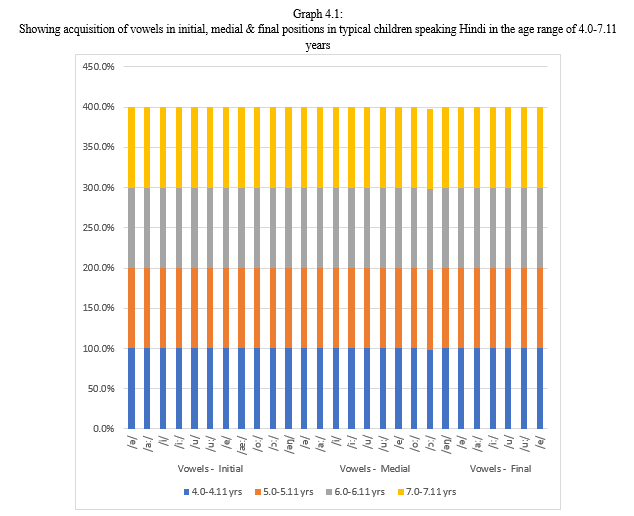
The results revealed that all the vowels except /??/ were acquired in initial, medial and final position of words before 4 years of age in Hindi speaking typical children. Vowel /??/ was acquired in initial & final positions in words by 4 years of age whereas it was achieved in medial position by 5 years. Comparison of the results was carried out which showed no significant difference across the age groups as well as between genders.
B. Consonants
Table 4.5:
Showing percentage score for consonants in initial position of words in Hindi & their comparative values across the age groups
|
|
4.0-4.11 yrs |
5.0-5.11 yrs |
6.0-6.11 yrs |
7.0-7.11 yrs |
Comparison between the age groups- p value |
|||||||||
|
Count |
% |
Count |
% |
Count |
% |
Count |
% |
5.0-5.11 yrs - 4.0-4.11 yrs |
6.0-6.11 yrs - 4.0-4.11 yrs |
7.0-7.11 yrs - 4.0-4.11 yrs |
6.0-6.11 yrs - 5.0-5.11 yrs |
7.0-7.11 yrs - 5.0-5.11 yrs |
7.0-7.11 yrs - 6.0-6.11 yrs |
|
|
Consonants – Initial |
Consonants – Initial |
|||||||||||||
|
/k/ |
50 |
100.0% |
50 |
100.0% |
50 |
100.0% |
50 |
100.0% |
1.000 |
1.000 |
1.000 |
1.000 |
1.000 |
1.000 |
|
/k?/ |
50 |
100.0% |
50 |
100.0% |
50 |
100.0% |
50 |
100.0% |
1.000 |
1.000 |
1.000 |
1.000 |
1.000 |
1.000 |
|
/?/ |
50 |
100.0% |
50 |
100.0% |
50 |
100.0% |
50 |
100.0% |
1.000 |
1.000 |
1.000 |
1.000 |
1.000 |
1.000 |
|
/??/ |
50 |
100.0% |
50 |
100.0% |
50 |
100.0% |
50 |
100.0% |
1.000 |
1.000 |
1.000 |
1.000 |
1.000 |
1.000 |
|
/t?/ |
50 |
100.0% |
50 |
100.0% |
50 |
100.0% |
50 |
100.0% |
1.000 |
1.000 |
1.000 |
1.000 |
1.000 |
1.000 |
|
/t??/ |
50 |
100.0% |
50 |
100.0% |
50 |
100.0% |
50 |
100.0% |
1.000 |
1.000 |
1.000 |
1.000 |
1.000 |
1.000 |
|
/d?/ |
50 |
100.0% |
50 |
100.0% |
50 |
100.0% |
50 |
100.0% |
1.000 |
1.000 |
1.000 |
1.000 |
1.000 |
1.000 |
|
/d??/ |
50 |
100.0% |
50 |
100.0% |
50 |
100.0% |
50 |
100.0% |
1.000 |
1.000 |
1.000 |
1.000 |
1.000 |
1.000 |
|
/?/ |
22 |
44.0% |
41 |
82.0% |
45 |
90.0% |
50 |
100.0% |
0.000 |
0.000 |
0.000 |
0.126 |
0.001 |
0.012 |
|
/??/ |
20 |
40.0% |
42 |
84.0% |
47 |
94.0% |
50 |
100.0% |
0.000 |
0.000 |
0.000 |
0.057 |
0.002 |
0.041 |
|
/?/ |
29 |
58.0% |
50 |
100.0% |
50 |
100.0% |
50 |
100.0% |
0.000 |
0.000 |
0.000 |
1.000 |
1.000 |
1.000 |
|
/??/ |
42 |
84.0% |
50 |
100.0% |
50 |
100.0% |
50 |
100.0% |
0.002 |
0.002 |
0.002 |
1.000 |
1.000 |
1.000 |
|
/t?/ |
50 |
100.0% |
50 |
100.0% |
50 |
100.0% |
50 |
100.0% |
1.000 |
1.000 |
1.000 |
1.000 |
1.000 |
1.000 |
|
/t??/ |
50 |
100.0% |
50 |
100.0% |
50 |
100.0% |
50 |
100.0% |
1.000 |
1.000 |
1.000 |
1.000 |
1.000 |
1.000 |
|
/d?/ |
50 |
100.0% |
50 |
100.0% |
50 |
100.0% |
50 |
100.0% |
1.000 |
1.000 |
1.000 |
1.000 |
1.000 |
1.000 |
|
/d??/ |
50 |
100.0% |
50 |
100.0% |
50 |
100.0% |
50 |
100.0% |
1.000 |
1.000 |
1.000 |
1.000 |
1.000 |
1.000 |
|
/n/ |
50 |
100.0% |
50 |
100.0% |
50 |
100.0% |
50 |
100.0% |
1.000 |
1.000 |
1.000 |
1.000 |
1.000 |
1.000 |
|
/p/ |
50 |
100.0% |
50 |
100.0% |
50 |
100.0% |
50 |
100.0% |
1.000 |
1.000 |
1.000 |
1.000 |
1.000 |
1.000 |
|
/p?/ |
50 |
100.0% |
50 |
100.0% |
50 |
100.0% |
50 |
100.0% |
1.000 |
1.000 |
1.000 |
1.000 |
1.000 |
1.000 |
|
/b/ |
50 |
100.0% |
50 |
100.0% |
50 |
100.0% |
50 |
100.0% |
1.000 |
1.000 |
1.000 |
1.000 |
1.000 |
1.000 |
|
/b?/ |
48 |
96.0% |
50 |
100.0% |
50 |
100.0% |
50 |
100.0% |
0.078 |
0.078 |
0.078 |
1.000 |
1.000 |
1.000 |
|
/m/ |
50 |
100.0% |
50 |
100.0% |
50 |
100.0% |
50 |
100.0% |
1.000 |
1.000 |
1.000 |
1.000 |
1.000 |
1.000 |
|
/j/ |
50 |
100.0% |
50 |
100.0% |
50 |
100.0% |
50 |
100.0% |
1.000 |
1.000 |
1.000 |
1.000 |
1.000 |
1.000 |
|
/r/ |
19 |
38.0% |
41 |
82.0% |
47 |
94.0% |
50 |
100.0% |
0.000 |
0.000 |
0.000 |
0.034 |
0.001 |
0.041 |
|
/l/ |
50 |
100.0% |
50 |
100.0% |
50 |
100.0% |
50 |
100.0% |
1.000 |
1.000 |
1.000 |
1.000 |
1.000 |
1.000 |
|
/?/ |
48 |
96.0% |
50 |
100.0% |
50 |
100.0% |
50 |
100.0% |
0.078 |
0.078 |
0.078 |
1.000 |
1.000 |
1.000 |
|
/?/ |
23 |
46.0% |
46 |
92.0% |
47 |
94.0% |
50 |
100.0% |
0.000 |
0.000 |
0.000 |
0.348 |
0.022 |
0.041 |
|
/s/ |
27 |
54.0% |
44 |
88.0% |
49 |
98.0% |
50 |
100.0% |
0.000 |
0.000 |
0.000 |
0.026 |
0.007 |
0.159 |
|
/h/ |
50 |
100.0% |
50 |
100.0% |
50 |
100.0% |
50 |
100.0% |
1.000 |
1.000 |
1.000 |
1.000 |
1.000 |
1.000 |
For initial position of consonant sounds in words, /?/, /??/, /?/, /??/, /?/ & /s/ showed highly significant difference in acquisition across age group comparisons (5.0-5.11 yrs – 4.0-4.11 yrs, 6.0-6.11 yrs – 4.0-4.11 yrs & 7.0-7.11 yrs – 4.0-4.11 yrs). /?/, /??/ & /?/ showed significant to highly significant difference also in age groups 7.0-7.11 yrs – 5.0-5.11 yrs and 7.0-7.11 yrs – 6.0-6.11 yrs. /s/ sound had significant to highly significant difference in age groups 6.0-6.11 yrs - 5.0-5.11 yrs & 7.0-7.11 yrs – 5.0-5.11 yrs as well; and /r/ showed significant to highly significant difference in acquisition across all the age groups. Whereas, no significant difference was seen between genders in the acquisition of consonant in initial position.
Table 4.6:
Showing percentage score for consonants in medial position of words in Hindi & their comparative values across the age groups
|
|
4.0-4.11 yrs |
5.0-5.11 yrs |
6.0-6.11 yrs |
7.0-7.11 yrs |
Comparison between the age groups- p value |
|||||||||
|
Count |
% |
Count |
% |
Count |
% |
Count |
% |
5.0-5.11 yrs - 4.0-4.11 yrs |
6.0-6.11 yrs - 4.0-4.11 yrs |
7.0-7.11 yrs - 4.0-4.11 yrs |
6.0-6.11 yrs - 5.0-5.11 yrs |
7.0-7.11 yrs - 5.0-5.11 yrs |
7.0-7.11 yrs - 6.0-6.11 yrs |
|
|
Consonants - Medial |
Consonants - Medial |
|||||||||||||
|
/k/ |
50 |
100.0% |
50 |
100.0% |
50 |
100.0% |
50 |
100.0% |
1.000 |
1.000 |
1.000 |
1.000 |
1.000 |
1.000 |
|
/k?/ |
50 |
100.0% |
50 |
100.0% |
50 |
100.0% |
50 |
100.0% |
1.000 |
1.000 |
1.000 |
1.000 |
1.000 |
1.000 |
|
/?/ |
50 |
100.0% |
50 |
100.0% |
50 |
100.0% |
50 |
100.0% |
1.000 |
1.000 |
1.000 |
1.000 |
1.000 |
1.000 |
|
/??/ |
50 |
100.0% |
50 |
100.0% |
50 |
100.0% |
50 |
100.0% |
1.000 |
1.000 |
1.000 |
1.000 |
1.000 |
1.000 |
|
/t?/ |
46 |
92.0% |
50 |
100.0% |
50 |
100.0% |
50 |
100.0% |
0.022 |
0.022 |
0.022 |
1.000 |
1.000 |
1.000 |
|
/t??/ |
50 |
100.0% |
47 |
94.0% |
50 |
100.0% |
50 |
100.0% |
0.041 |
1.000 |
1.000 |
0.041 |
0.041 |
1.000 |
|
/d?/ |
50 |
100.0% |
50 |
100.0% |
50 |
100.0% |
50 |
100.0% |
1.000 |
1.000 |
1.000 |
1.000 |
1.000 |
1.000 |
|
/?/ |
22 |
44.0% |
43 |
86.0% |
46 |
92.0% |
50 |
100.0% |
0.000 |
0.000 |
0.000 |
0.170 |
0.004 |
0.022 |
|
/??/ |
30 |
60.0% |
44 |
88.0% |
49 |
98.0% |
50 |
100.0% |
0.001 |
0.000 |
0.000 |
0.026 |
0.007 |
0.159 |
|
/??/ |
42 |
84.0% |
50 |
100.0% |
50 |
100.0% |
50 |
100.0% |
0.002 |
0.002 |
0.002 |
1.000 |
1.000 |
1.000 |
|
/t?/ |
42 |
84.0% |
49 |
98.0% |
50 |
100.0% |
50 |
100.0% |
0.008 |
0.002 |
0.002 |
0.159 |
0.159 |
1.000 |
|
/t??/ |
50 |
100.0% |
50 |
100.0% |
50 |
100.0% |
50 |
100.0% |
1.000 |
1.000 |
1.000 |
1.000 |
1.000 |
1.000 |
|
/d?/ |
50 |
100.0% |
50 |
100.0% |
50 |
100.0% |
50 |
100.0% |
1.000 |
1.000 |
1.000 |
1.000 |
1.000 |
1.000 |
|
/n/ |
50 |
100.0% |
50 |
100.0% |
50 |
100.0% |
50 |
100.0% |
1.000 |
1.000 |
1.000 |
1.000 |
1.000 |
1.000 |
|
/p/ |
50 |
100.0% |
50 |
100.0% |
50 |
100.0% |
50 |
100.0% |
1.000 |
1.000 |
1.000 |
1.000 |
1.000 |
1.000 |
|
/p?/ |
42 |
84.0% |
50 |
100.0% |
50 |
100.0% |
50 |
100.0% |
0.002 |
0.002 |
0.002 |
1.000 |
1.000 |
1.000 |
|
/b/ |
50 |
100.0% |
50 |
100.0% |
50 |
100.0% |
50 |
100.0% |
1.000 |
1.000 |
1.000 |
1.000 |
1.000 |
1.000 |
|
/m/ |
50 |
100.0% |
50 |
100.0% |
50 |
100.0% |
50 |
100.0% |
1.000 |
1.000 |
1.000 |
1.000 |
1.000 |
1.000 |
|
/j/ |
43 |
86.0% |
50 |
100.0% |
50 |
100.0% |
50 |
100.0% |
0.004 |
0.004 |
0.004 |
1.000 |
1.000 |
1.000 |
|
/r/ |
25 |
50.0% |
47 |
94.0% |
47 |
94.0% |
50 |
100.0% |
0.000 |
0.000 |
0.000 |
0.500 |
0.041 |
0.041 |
|
/l/ |
50 |
100.0% |
50 |
100.0% |
50 |
100.0% |
50 |
100.0% |
1.000 |
1.000 |
1.000 |
1.000 |
1.000 |
1.000 |
|
/?/ |
40 |
80.0% |
50 |
100.0% |
50 |
100.0% |
50 |
100.0% |
0.001 |
0.001 |
0.001 |
1.000 |
1.000 |
1.000 |
|
/?/ |
28 |
56.0% |
47 |
94.0% |
47 |
94.0% |
50 |
100.0% |
0.000 |
0.000 |
0.000 |
0.500 |
0.041 |
0.041 |
|
/s/ |
32 |
64.0% |
46 |
92.0% |
49 |
98.0% |
50 |
100.0% |
0.001 |
0.000 |
0.000 |
0.086 |
0.022 |
0.159 |
|
/h/ |
50 |
100.0% |
50 |
100.0% |
50 |
100.0% |
50 |
100.0% |
1.000 |
1.000 |
1.000 |
1.000 |
1.000 |
1.000 |
For medial position of consonant sounds in words, /t?/, /?/, /??/, /??/, /t?/, /p?/, /j/, /r/, /?/, /?/ & /s/ showed highly significant difference in acquisition across age group comparisons (5.0-5.11 yrs – 4.0-4.11 yrs, 6.0-6.11 yrs – 4.0-4.11 yrs & 7.0-7.11 yrs – 4.0-4.11 yrs). /?/, /r/ & /?/ showed significant difference also in age groups 7.0-7.11 yrs – 5.0-5.11 yrs and 7.0-7.11 yrs – 6.0-6.11 yrs. /t??/ & /??/ sound had significant difference in age groups 6.0-6.11 yrs - 5.0-5.11 yrs & 7.0-7.11 yrs – 5.0-5.11 yrs as well. Whereas a significant difference was seen between genders in the acquisition of consonant /s/ in the age group of 4.0-4.11 years.
Table 4.7:
Showing percentage score for consonants in final position of words in Hindi & their comparative values across the age groups
|
|
4.0-4.11 yrs |
5.0-5.11 yrs |
6.0-6.11 yrs |
7.0-7.11 yrs |
Comparison between the age groups- p value |
|||||||||
|
Count |
% |
Count |
% |
Count |
% |
Count |
% |
5.0-5.11 yrs - 4.0-4.11 yrs |
6.0-6.11 yrs - 4.0-4.11 yrs |
7.0-7.11 yrs - 4.0-4.11 yrs |
6.0-6.11 yrs - 5.0-5.11 yrs |
7.0-7.11 yrs - 5.0-5.11 yrs |
7.0-7.11 yrs - 6.0-6.11 yrs |
|
|
Consonants - Final |
Consonants - Final |
|||||||||||||
|
/k/ |
50 |
100.0% |
50 |
100.0% |
50 |
100.0% |
50 |
100.0% |
1.000 |
1.000 |
1.000 |
1.000 |
1.000 |
1.000 |
|
/k?/ |
50 |
100.0% |
50 |
100.0% |
50 |
100.0% |
50 |
100.0% |
1.000 |
1.000 |
1.000 |
1.000 |
1.000 |
1.000 |
|
/?/ |
50 |
100.0% |
50 |
100.0% |
50 |
100.0% |
50 |
100.0% |
1.000 |
1.000 |
1.000 |
1.000 |
1.000 |
1.000 |
|
/??/ |
50 |
100.0% |
50 |
100.0% |
50 |
100.0% |
50 |
100.0% |
1.000 |
1.000 |
1.000 |
1.000 |
1.000 |
1.000 |
|
/t?/ |
50 |
100.0% |
50 |
100.0% |
50 |
100.0% |
50 |
100.0% |
1.000 |
1.000 |
1.000 |
1.000 |
1.000 |
1.000 |
|
/t??/ |
49 |
98.0% |
49 |
98.0% |
50 |
100.0% |
50 |
100.0% |
0.500 |
0.159 |
0.159 |
0.159 |
0.159 |
1.000 |
|
/d?/ |
50 |
100.0% |
50 |
100.0% |
50 |
100.0% |
50 |
100.0% |
1.000 |
1.000 |
1.000 |
1.000 |
1.000 |
1.000 |
|
/?/ |
29 |
58.0% |
43 |
86.0% |
46 |
92.0% |
50 |
100.0% |
0.001 |
0.000 |
0.000 |
0.170 |
0.004 |
0.022 |
|
/??/ |
28 |
56.0% |
44 |
88.0% |
48 |
96.0% |
50 |
100.0% |
0.000 |
0.000 |
0.000 |
0.072 |
0.007 |
0.078 |
|
/?/ |
34 |
68.0% |
48 |
96.0% |
48 |
96.0% |
50 |
100.0% |
0.000 |
0.000 |
0.000 |
0.500 |
0.078 |
0.078 |
|
/t?/ |
50 |
100.0% |
50 |
100.0% |
50 |
100.0% |
50 |
100.0% |
1.000 |
1.000 |
1.000 |
1.000 |
1.000 |
1.000 |
|
/t??/ |
50 |
100.0% |
50 |
100.0% |
50 |
100.0% |
50 |
100.0% |
1.000 |
1.000 |
1.000 |
1.000 |
1.000 |
1.000 |
|
/d?/ |
50 |
100.0% |
50 |
100.0% |
50 |
100.0% |
50 |
100.0% |
1.000 |
1.000 |
1.000 |
1.000 |
1.000 |
1.000 |
|
/d??/ |
50 |
100.0% |
50 |
100.0% |
50 |
100.0% |
50 |
100.0% |
1.000 |
1.000 |
1.000 |
1.000 |
1.000 |
1.000 |
|
/n/ |
50 |
100.0% |
50 |
100.0% |
50 |
100.0% |
50 |
100.0% |
1.000 |
1.000 |
1.000 |
1.000 |
1.000 |
1.000 |
|
/p/ |
50 |
100.0% |
50 |
100.0% |
50 |
100.0% |
50 |
100.0% |
1.000 |
1.000 |
1.000 |
1.000 |
1.000 |
1.000 |
|
/p?/ |
47 |
94.0% |
50 |
100.0% |
50 |
100.0% |
50 |
100.0% |
0.041 |
0.041 |
0.041 |
1.000 |
1.000 |
1.000 |
|
/b/ |
50 |
100.0% |
50 |
100.0% |
50 |
100.0% |
50 |
100.0% |
1.000 |
1.000 |
1.000 |
1.000 |
1.000 |
1.000 |
|
/b?/ |
50 |
100.0% |
50 |
100.0% |
50 |
100.0% |
50 |
100.0% |
1.000 |
1.000 |
1.000 |
1.000 |
1.000 |
1.000 |
|
/m/ |
50 |
100.0% |
50 |
100.0% |
50 |
100.0% |
50 |
100.0% |
1.000 |
1.000 |
1.000 |
1.000 |
1.000 |
1.000 |
|
/j/ |
50 |
100.0% |
50 |
100.0% |
50 |
100.0% |
50 |
100.0% |
1.000 |
1.000 |
1.000 |
1.000 |
1.000 |
1.000 |
|
/r/ |
43 |
86.0% |
47 |
94.0% |
47 |
94.0% |
50 |
100.0% |
0.093 |
0.093 |
0.004 |
0.500 |
0.041 |
0.041 |
|
/l/ |
50 |
100.0% |
50 |
100.0% |
50 |
100.0% |
50 |
100.0% |
1.000 |
1.000 |
1.000 |
1.000 |
1.000 |
1.000 |
|
/?/ |
40 |
80.0% |
50 |
100.0% |
50 |
100.0% |
50 |
100.0% |
0.001 |
0.001 |
0.001 |
1.000 |
1.000 |
1.000 |
|
/?/ |
29 |
58.0% |
47 |
94.0% |
47 |
94.0% |
50 |
100.0% |
0.000 |
0.000 |
0.000 |
0.500 |
0.041 |
0.041 |
|
/s/ |
37 |
74.0% |
45 |
90.0% |
49 |
98.0% |
50 |
100.0% |
0.020 |
0.000 |
0.000 |
0.048 |
0.012 |
0.159 |
|
/h/ |
50 |
100.0% |
50 |
100.0% |
50 |
100.0% |
50 |
100.0% |
1.000 |
1.000 |
1.000 |
1.000 |
1.000 |
1.000 |
For final position of consonant sounds in words, /?/, /??/ & /?/ showed highly significant and /p?/ showed significant difference in acquisition across age group comparisons (5.0-5.11 yrs – 4.0-4.11 yrs, 6.0-6.11 yrs – 4.0-4.11 yrs & 7.0-7.11 yrs – 4.0-4.11 yrs). /?/, /r/ & /?/ showed significant difference also in age groups 7.0-7.11 yrs – 5.0-5.11 yrs and 7.0-7.11 yrs – 6.0-6.11 yrs. /r/ showed highly significant difference in the age group 7.0-7.11 yrs – 4.0-4.11 yrs also; /s/ showed significant to highly significant difference across the age groups 6.0-6.11 yrs - 4.0-4.11 yrs, 7.0-7.11 yrs – 4.0-4.11, 6.0-6.11 yrs - 5.0-5.11 yrs & 7.0-7.11 yrs – 5.0-5.11 yrs. Whereas a significant difference was seen between genders in the acquisition of consonant /s/ in the age group of 4.0-4.11 years.
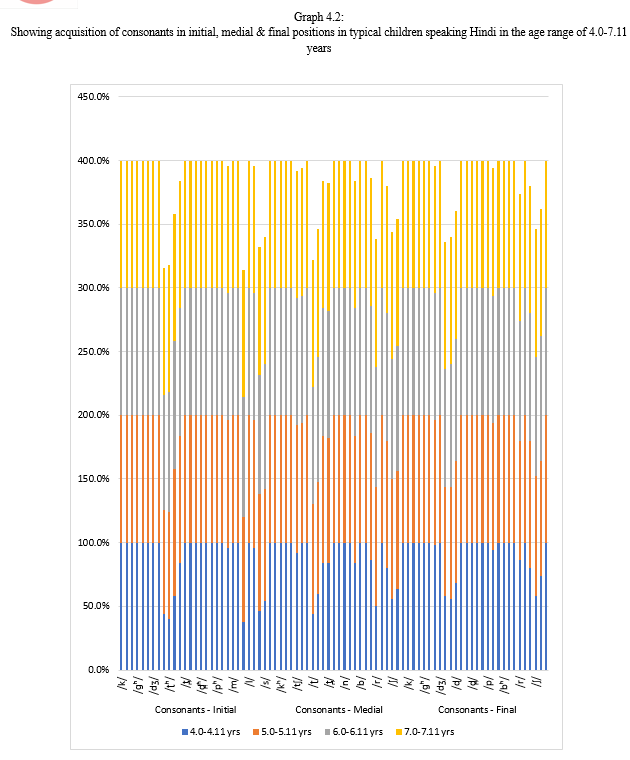
Table 4.8:
Showing acquisition of Hindi consonants as found in the present study
|
Consonants |
Age (in years) |
||
|
Initial |
Medial |
Final |
|
|
/k/ |
Before 4 |
Before 4 |
Before 4 |
|
/k?/ |
Before 4 |
Before 4 |
Before 4 |
|
/?/ |
Before 4 |
Before 4 |
Before 4 |
|
/??/ |
Before 4 |
Before 4 |
Before 4 |
|
/t?/ |
Before 4 |
5 |
Before 4 |
|
/t??/ |
Before 4 |
Before 4 |
6 ½ |
|
/d?/ |
Before 4 |
Before 4 |
Before 4 |
|
/d??/ |
Before 4 |
- |
- |
|
/?/ |
7 ½ |
7 ½ |
7 ½ |
|
/??/ |
7 ½ |
7 ½ |
7 ½ |
|
/?/ |
5 ½ |
- |
7 |
|
/??/ |
5 ½ |
5 ½ |
- |
|
/t?/ |
Before 4 |
6 |
Before 4 |
|
/t??/ |
Before 4 |
Before 4 |
Before 4 |
|
/d?/ |
Before 4 |
Before 4 |
Before 4 |
|
/d??/ |
Before 4 |
- |
Before 4 |
|
/n/ |
Before 4 |
Before 4 |
Before 4 |
|
/p/ |
Before 4 |
Before 4 |
Before 4 |
|
/p?/ |
Before 4 |
5 |
5 |
|
/b/ |
Before 4 |
Before 4 |
Before 4 |
|
/b?/ |
5 |
- |
Before 4 |
|
/m/ |
Before 4 |
Before 4 |
Before 4 |
|
/j/ |
Before 4 |
5 ½ |
Before 4 |
|
/r/ |
7 ½ |
7 ½ |
7 ½ |
|
/l/ |
Before 4 |
Before 4 |
Before 4 |
|
/?/ |
5 ½ |
5 ½ |
5 ½ |
|
/?/ |
7 ½ |
7 ½ |
7 ½ |
|
/s/ |
7 ½ |
7 ½ |
7 ½ |
|
/h/ |
Before 4 |
Before 4 |
Before 4 |
C. Compound Consonants
Table 4.9:
Showing percentage score for compound consonants in initial, medial & final position of words in Hindi & their comparative values across the age groups
|
|
4.0-4.11 yrs |
5.0-5.11 yrs |
6.0-6.11 yrs |
7.0-7.11 yrs |
Comparison between the age groups- p value |
|||||||||
|
Count |
% |
Count |
% |
Count |
% |
Count |
% |
5.0-5.11 yrs - 4.0-4.11 yrs |
6.0-6.11 yrs - 4.0-4.11 yrs |
7.0-7.11 yrs - 4.0-4.11 yrs |
6.0-6.11 yrs - 5.0-5.11 yrs |
7.0-7.11 yrs - 5.0-5.11 yrs |
7.0-7.11 yrs - 6.0-6.11 yrs |
|
|
Compound Consonants-Initial |
Compound Consonants-Initial |
|||||||||||||
|
/k?/ |
36 |
72.0% |
48 |
96.0% |
49 |
98.0% |
50 |
100.0% |
0.001 |
0.000 |
0.000 |
0.280 |
0.078 |
0.159 |
|
/t??/ |
31 |
62.0% |
40 |
80.0% |
48 |
96.0% |
48 |
96.0% |
0.025 |
0.000 |
0.000 |
0.008 |
0.008 |
0.500 |
|
/?j/ |
10 |
20.0% |
45 |
90.0% |
46 |
92.0% |
47 |
94.0% |
0.000 |
0.000 |
0.000 |
0.364 |
0.231 |
0.348 |
|
Compound Consonants -Medial |
Compound Consonants -Medial |
|||||||||||||
|
/k?/ |
30 |
60.0% |
43 |
86.0% |
49 |
98.0% |
49 |
98.0% |
0.002 |
0.000 |
0.000 |
0.015 |
0.015 |
0.500 |
|
/t??/ |
28 |
56.0% |
46 |
92.0% |
47 |
94.0% |
48 |
96.0% |
0.000 |
0.000 |
0.000 |
0.348 |
0.201 |
0.324 |
|
Compound Consonants -Final |
Compound Consonants -Final |
|||||||||||||
|
/k?/ |
16 |
32.0% |
42 |
84.0% |
47 |
94.0% |
49 |
98.0% |
0.000 |
0.000 |
0.000 |
0.057 |
0.008 |
0.155 |
|
/t??/ |
15 |
30.0% |
39 |
78.0% |
46 |
92.0% |
48 |
96.0% |
0.000 |
0.000 |
0.000 |
0.026 |
0.004 |
0.201 |
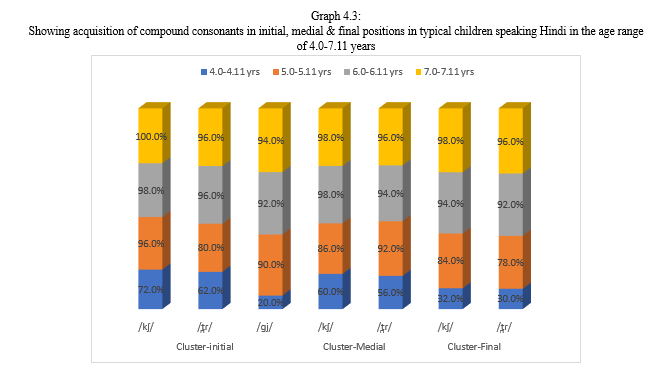
The results indicated that none of the compound consonants, except /k?/ in initial position, were fully acquired in all the three positions in words by the age of 7.11 years. Highly significant difference was revealed for all the compound consonants across initial, medial & final positions in words on comparison across the age groups (5.0-5.11 yrs – 4.0-4.11 yrs, 6.0-6.11 yrs – 4.0-4.11 yrs & 7.0-7.11 yrs – 4.0-4.11 yrs). Additionally, similar results were found for /t??/ in initial position across the age groups of 6.0-6.11 yrs - 5.0-5.11 yrs & 7.0-7.11 yrs – 5.0-5.11 yrs; for /k?/ in medial position across the age groups of 6.0-6.11 yrs - 5.0-5.11 yrs & 7.0-7.11 yrs – 5.0-5.11 yrs as well. For final position in words, highly significant results were also seen for /k?/ in the comparison of age groups 7.0-7.11 yrs – 5.0-5.11 yrs; for /t??/ sound across the age comparison of 6.0-6.11 yrs – 5.0-5.11 yrs & 7.0-7.11 yrs – 5.0-5.11 yrs. Whereas, a significant difference was seen between genders in the acquisition of /t??/ at final position in words in the age group of 4.0-4.11 years.
Ruas (1989) found in typical children speaking Hindi, /?/ is acquired as early as 3 and half years. /m/, /t?/, /d?/ & /n/ before 3 years. /p/, /?/ & /r/ at 4, /k/, /g/, /t?/ & /l/ at 4 and half years. /s/, /t/, /j/ & /l/ at 5 years. The results of the present study do not correlate with the previous study results. The overall acquisition of phonemes is seen to be delayed as compared with the previous study. This can be due to the fact that the typical children start schooling by the age of 4 years and the mode of instruction in schools is English. Even though the subjects taken for the study were native Hindi speakers, but they start acquisition of English as second language (L2) simultaneously during the early years of life when the acquisition of Hindi as first language (L1) has not been achieved completely. This study is indicative of the fact that there is a pressing effect of L2 on the acquisition of L1 in young school going children. This is supported by the western studies in this tradition who have looked at L2 effects in cases where individuals clearly are losing their ability to function in the LI (Jaspaert & Kroon, 1992; Kaufman & Aronoff, 1991; Kouritzin, 1999). However, there is a lack of such evidences in Indian languages.
The acquisition of phonemes in other Indian languages is as follows:
- Kannada Picture Articulation Test by Babu, Rathna & Betageri (1972)- /p/, /b/, /m/, /t?/, /d?/, /n/, /k/, /g/, /t/, /j/ and /I/ sounds are acquired before 3 years. /t?/ is acquired at 4 and /d/ and /?/ are acquired at the age of 4 and half years. /l/, /s/ & /r/ are acquired at 5 years and /?/ is acquired at 6 years.
- Tamil Picture Articulation Test by Usha & Karanth (1986)- /p/, /b/, /m/, /t?/, /d?/ & /n/ sounds are acquired before 3 years of age. /t?/ is acquired at 4 and half. /s/, /r/, /t/, /j/ & /l/ are seen to be acquired at the age of 5 and half years.
- Picture Articulation Test in Bengali by Banik & Barman (1988)- /m/, /t?/, /d?/ & /n/ are acquired before 3 years. /p/, /b/, /?/ & /r/ at 4 years. /k/ & /g/ at 4 and half years. /s/, /t/, /j/ & /?/ are acquired at 5 years. /l/ is seen to be acquired at 5 and half years.
- Picture Articulation Test in Malayalam by Manoj (1998)- /p/, /b/, /m/, /t?/, /d?/, /n/, /k/, /g/, /t/, /d/, /t?/, /?/ & /?/ are acquired before 3 years of age. /s/ & /I/ acquired at 4 and half and /r/, /l/ & /j/ at 5 years of age.
- Picture Articulation Test in Konkani by D’ Souza & Rao (2001)- /p/, /b/, /m/, /t?/, /d?/, /t/ & /d/ are acquired before 3 years. /k/, /g/ /I/ & /j/ were achieved at 3 and half years. /?/ at 4, /s/ at 4 and half. /l/ at 5, /?/ by 5 and half and /t?/ was achieved by 7 and half years.
- Picture Articulation Test in Coorgie by Somanna & Varghese (2007)- /p/, /b/, /m/, /t?/, /d?/, /n/, /k/, /g/, /t/, /d/ & /?/ are achieved before 3 years of age. /s/, /r/, /t?/, /?/, /l/ & /j/ at 3 and half years.
- Picture Articulation Test in Tulu by Parinitha & Prabhu (2010)- /p/, /b/, /m/, /t?/, /d?/, /n/, /k/, /g/, /t/, /d/, /t?/, /?/ & /?/ are acquired before 3 years of age. /r/ by 4 and half years and /l/ is achieved by 5 and half years.
- Picture Articulation Test in Kashmiri by Shamiya & Kumaraswamy (2019)- /p/, /b/, /n/, /m/ & /p?/ are acquired by 3 years. /k/, /g/, /h/, /j/, /k?/ & /d?/ by 4 years, /z/ & /v/ by 5 years and /s/, /r/, /l/, /t?/, /?/ & /t??/ are achieved by 51/2-6 years of age.
The Revised Picture Articulation Test in Hindi is useful for both assessment of articulatory problems and for monitoring the progress during therapy. The comparative values across various age groups provide clear evidence that articulation skills increase with age.
As an assessment tool, it helps in finding the baseline of the child. From the baseline, one can get the following information:
a. Estimate of the number of sounds misarticulated by the child
b. Whether the articulation errors made are age appropriate, as given by the norms of this test
c. The positions where the misarticulation occurred
d. The type of misarticulation occurred
e. Whether the misarticulation occurred
f. Whether misarticulation occurred at phoneme level or cluster level only.
Different clients respond differently to various treatment techniques. Therefore, based on the scores obtained on this test, we can infer the following:
- The effectiveness of a technique for the client can be judged
- The need for change, if any, in the approach being used can also be indicated through the test.
- This test then can be used with various disorders e.g., misarticulation due to cerebral palsy, cleft lip and cleft palate, mentally challenged, developmental apraxia of speech, children with functional misarticulation, dysarthria, etc.
The Revised Picture Articulation Test in Hindi seems to be a promising tool for assessment and treatment of Hindi speaking children with speech sound disorder. This, it is a useful tool for a speech language pathologist.
APPENDIX – I
Recording Sheet
Name: Age: Gender:
|
S. No. |
Sound |
Section I - Vowels |
I |
M |
F |
Comments |
||
|
Initial |
Medial |
Final |
||||||
|
V1 |
/?/ |
/?n??r/ (pomegranate) |
/m?t?r/ (peas) |
/b?s/ (bus) |
||||
|
V2 |
/a?/ |
/a:m/ (mango) |
/?n???/ (pomegranate) |
/t????.t???/ (umbrella) |
||||
|
V3 |
/i/ |
/imli:/ (tamarind) |
/t??kija:/ (pillow) |
|||||
|
V4 |
/i?/ |
/t?i:n/ (three) |
/b?gi:t?a:/ (garden) |
/d??lebi:/ (funnel cake) |
||||
|
V5 |
/u/ |
/ullu:/ (owl) |
/sa:bun/ (soap) |
/sa:d??u/ (monk) |
||||
|
V6 |
/u:/ |
/u:nt/ (camel) |
/k?bu:t??r/ (pigeon) |
/b?a:lu:/ (bear) |
||||
|
V7 |
/e/ |
/pe??/ (tree) |
/d??lebi:/ (funnel cake) |
/gubba:re/ (balloons) |
||||
|
V8 |
/æ?/ |
/æ?n?k/ (eyeglasses) |
||||||
|
V9 |
/o?/ |
/o:k??li:/ (mortar) |
/s?mo:sa:/ (rissole) |
|||||
|
V10 |
/??/ |
/k??a:/ (crow) |
/k?il??na:/ (toy) |
|||||
|
V11 |
/??/ |
/??gu:r/ (grapes) |
/p?t???g/ (kite) |
|||||
|
Section II - Consonants |
||||||||
|
C1 |
/k/ |
/k?m?l/ (lotus) |
/b?k?ri:/ (goat) |
/me?n???k/ (frog) |
||||
|
C2 |
/k?/ |
/k??rgo:?/ (rabbit) |
/o:k??li:/ (mortar) |
/b?t?t??k?/ (duck) |
||||
|
C3 |
/?/ |
/ga:d??r/ (carrot) |
/m???rm?t?t??/ (crocodile) |
/p?t???g/ (kite) |
||||
|
C4 |
/??/ |
/??o??a?/ (horse) |
/g?a?g??ra?/ (skirt) |
/k??g?a?/ (comb) |
||||
|
C5 |
/t?/ |
/t??pp?l/ (slippers) |
/na:t?na:/ (to dance) |
/b?t?t?a:/ (child) |
||||
|
C6 |
/t??/ |
/t??a?t?a?/ (umbrella) |
/m?t???li:/ (fish) |
/m???rm?t?t??/ (crocodile) |
||||
|
C7 |
/d?/ |
/d??ha:d?/ (ship) |
/ga:d??r/ (carrot) |
/d??ha:d?/ (ship) |
||||
|
C8 |
/d??/ |
/d???nda:/ (flag) |
||||||
|
C9 |
/?/ |
/t?ma:t?r/ (tomato) |
/b?t?n/ (button) |
/u:nt/ (camel) |
||||
|
C10 |
/??/ |
/?????e:ra:/ (tinker) |
/mi??a:i:/ (sweets) |
/??gu:??i:/ (ring) |
||||
|
C11 |
/?/ |
/??m?ru?/ (pellet drum) |
/d???nda:/ (flag) |
|||||
|
C12 |
/??/ |
/??o?l?k/ (dholak) |
/me?n???k/ (frog) |
|||||
|
C13 |
/t?/ |
/t??l?a?r/ (sword) |
/b?t?t??k?/ (duck) |
/d?a?nt?/ (teeth) |
||||
|
C14 |
/t??/ |
/t???r?m?s/ (thermos flask) |
/h?t??e?li?/ (palm) |
/ha?t??i?/ (elephant) |
||||
|
C15 |
/d?/ |
/d?a?nt?/ (teeth) |
/m?d?a?ri?/ (juggler) |
/?m?ru:d?/ (guava) |
||||
|
C16 |
/d??/ |
/d???nu?/ (bow) |
/g?d??a?/ (donkey) |
|||||
|
C17 |
/n/ |
/n?l/ (tap) |
/æ?n?k/ (eyeglasses) |
/ka:n/ (ear) |
||||
|
C18 |
/p/ |
/p?pi:t?a:/ (papaya) |
/t??pp?l/ (slippers) |
/sa:np/ (snake) |
||||
|
C19 |
/p?/ |
/p?u:l/ (flower) |
/???p??li?/ (tambourine) |
/so?p?a?/ (couch) |
||||
|
C20 |
/b/ |
/bæ?ng?n/ (brinjal) |
/k?bu:t??r/ (pigeon) |
/d??lebi:/ (funnel cake) |
||||
|
C21 |
/b?/ |
/b?a:lu:/ (bear) |
/k??mb?a?/ (pillar) |
|||||
|
C22 |
/m/ |
/m?t???li:/ (fish) |
/t?ma:t?r/ (tomato) |
/k?l?m/ (pen) |
||||
|
C23 |
/j/ |
/j?gj?/ (fire ritual) |
/na?rij?l/ (coconut) |
/t?a:j/ (tea) |
||||
|
C24 |
/r/ |
/re?l?ga??i?/ (train) |
/k??rgo:?/ (rabbit) |
/m?t?r/ (peas) |
||||
|
C25 |
/l/ |
/l?ttu:/ (spinning top) |
/k?l?m/ (pen) |
/ullu:/ (owl) |
||||
|
C26 |
/?/ |
/?a:n?r/ (monkey) |
/t??l?va?r/ (sword) |
/na:?/ (boat) |
||||
|
C27 |
/?/ |
/??h?d?/ (honey) |
/m??i:n/ (machine) |
/d???nu?/ (bow) |
||||
|
C28 |
/s/ |
/su?r?d?/ (sun) |
/kisa:n/ (farmer) |
/s?mo:sa:/ (rissole) |
||||
|
C29 |
/h/ |
/ha?t??i?/ (elephant) |
/??h?d?/ (honey) |
/sipa:hi:/ (soldier) |
||||
|
Section III – Compound Consonants |
||||||||
|
S. No. |
Sound |
Initial |
Medial |
Final |
I |
M |
F |
Comments |
|
CL1 |
/k?/ |
/k??t?rij?/ (warrior) |
/ra?k??s/ (demon) |
/?r?k??/ (tree) |
||||
|
CL2 |
/t??/ |
/t?ri?u?l/ (trident) |
/k??t?rij?/ (warrior) |
/p?t???/ (letter) |
||||
|
CL3 |
/?j/ |
/j?gj?/ (fire ritual) |
||||||
|
? |
Correct response |
|
S |
Substitution |
|
O |
Omission |
|
D |
Distortion |
|
A |
Addition |
|
R |
Repetition |
-Corresponding pictures are available in Appendix II
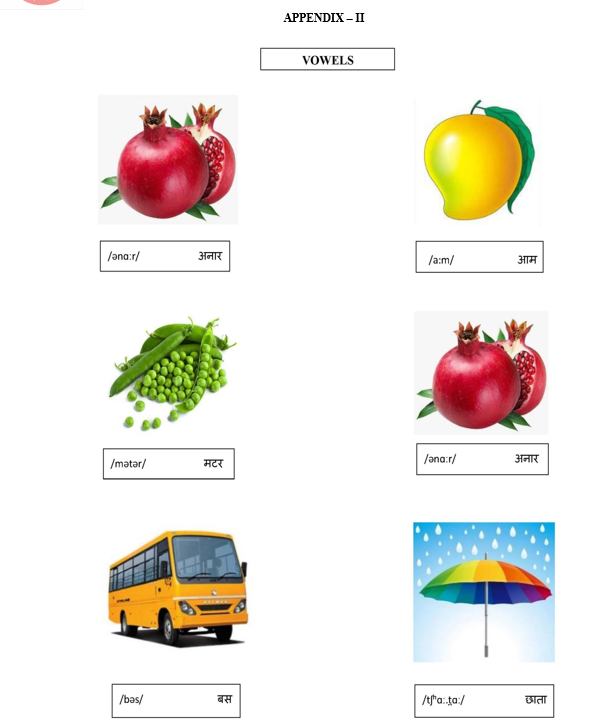
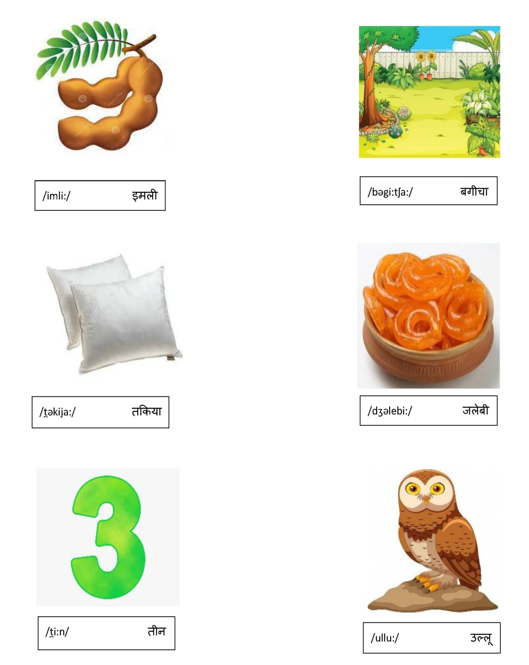
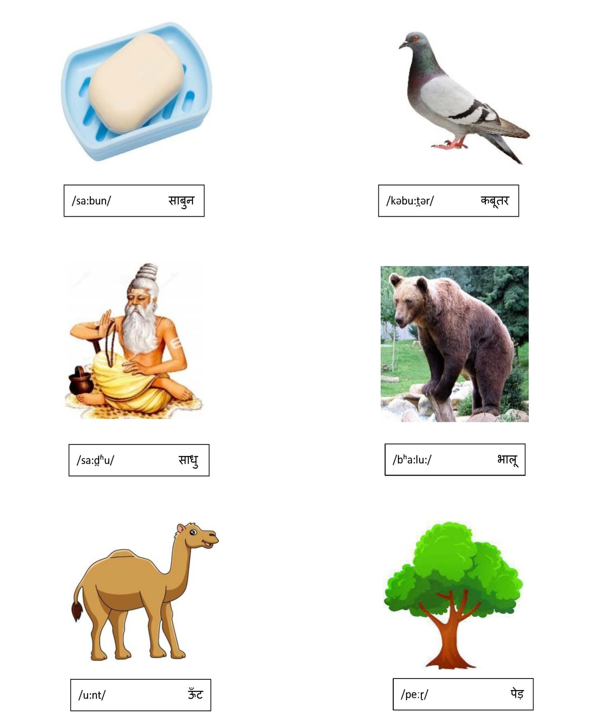
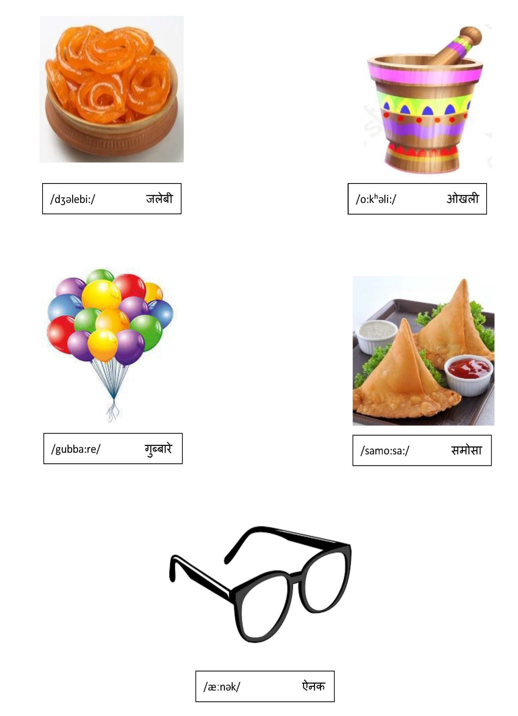
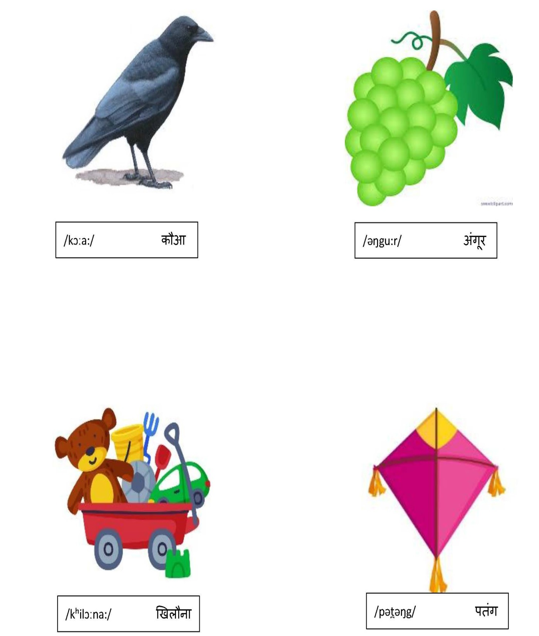
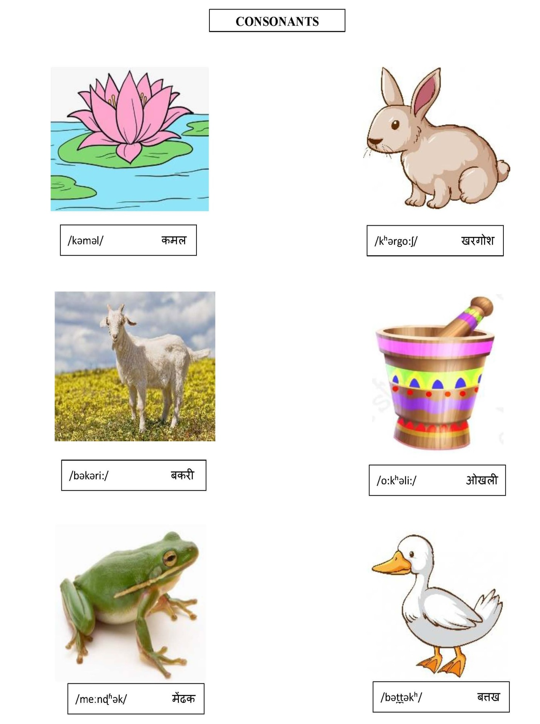
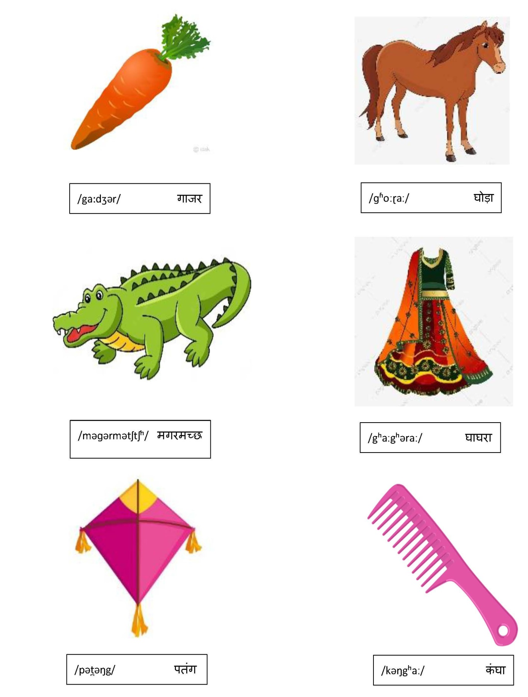
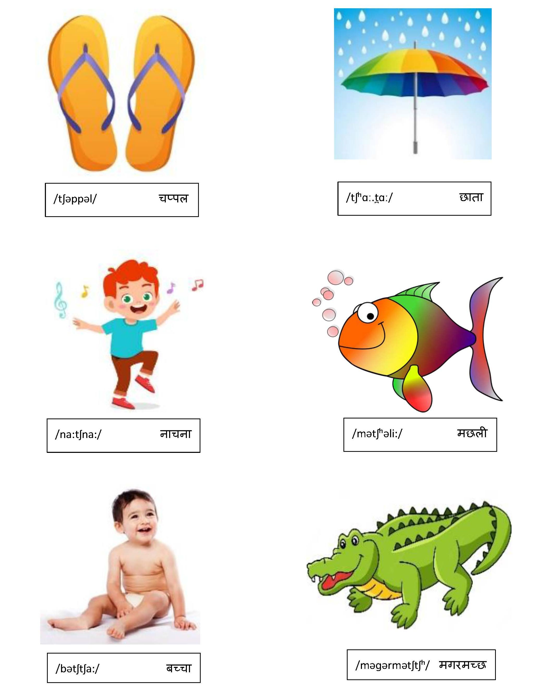
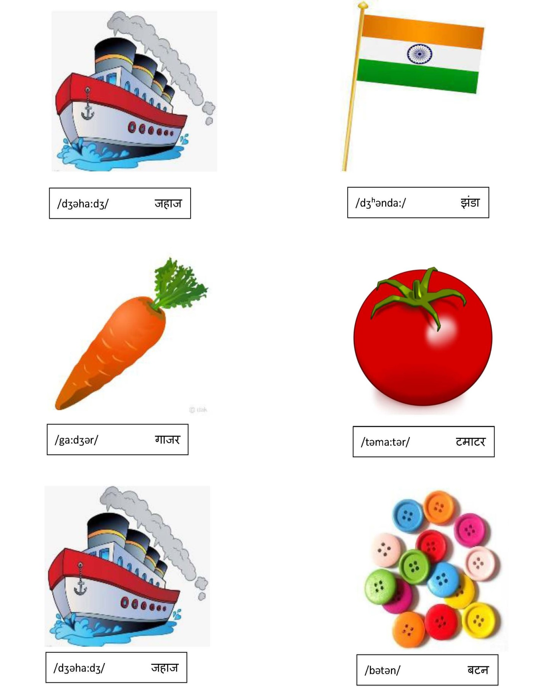

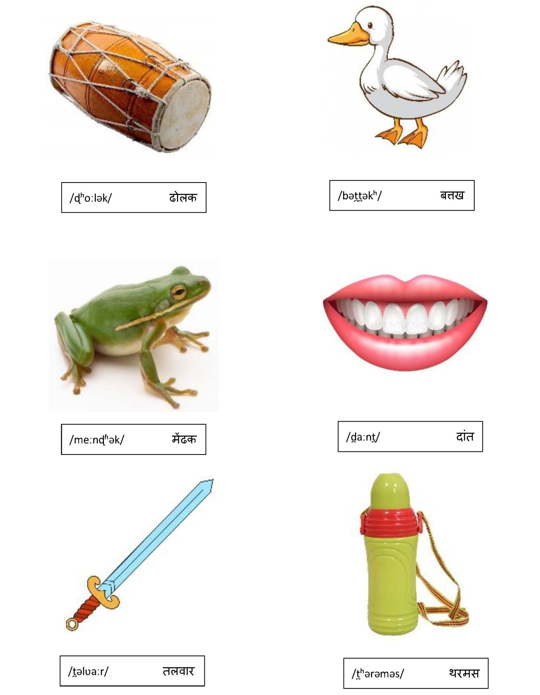
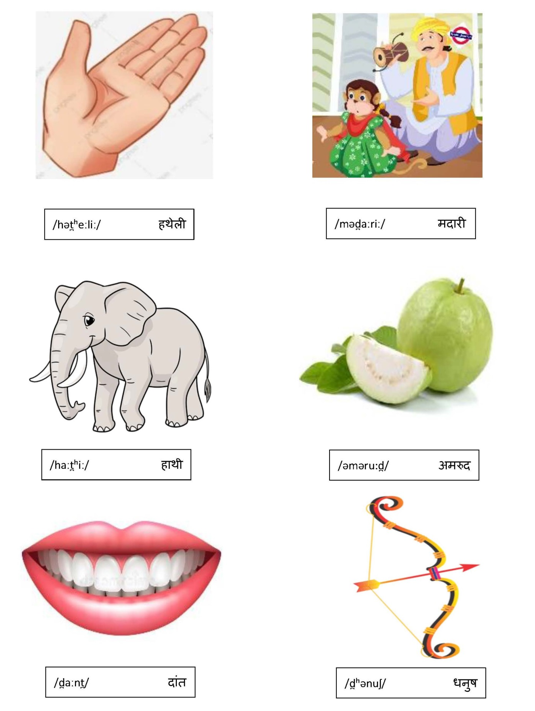

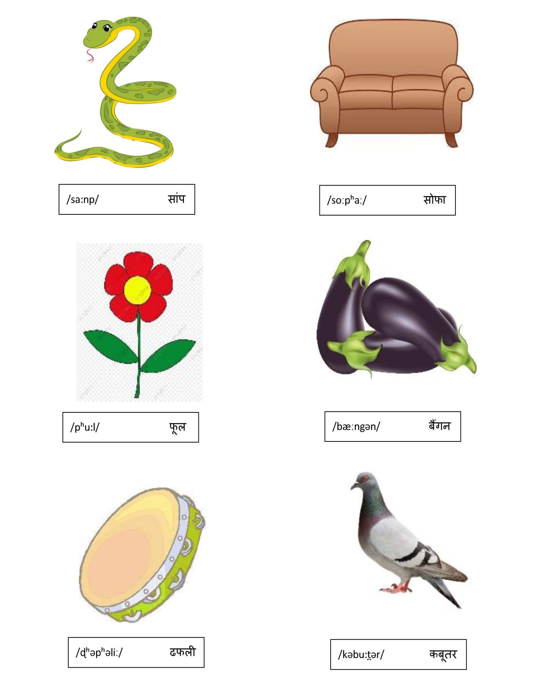
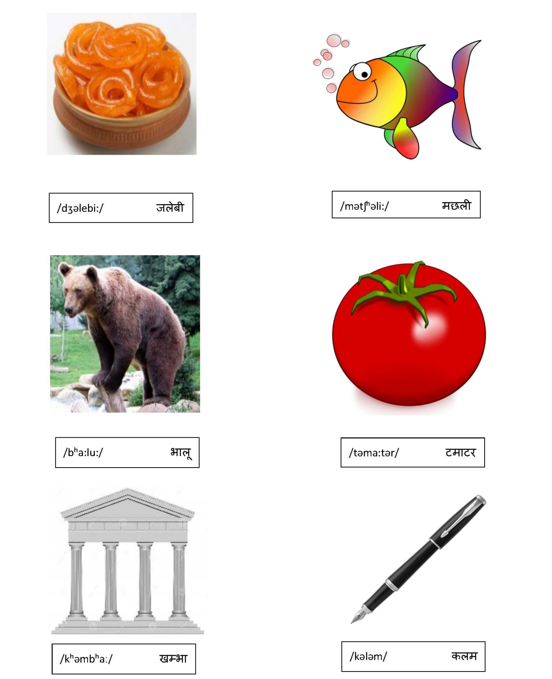
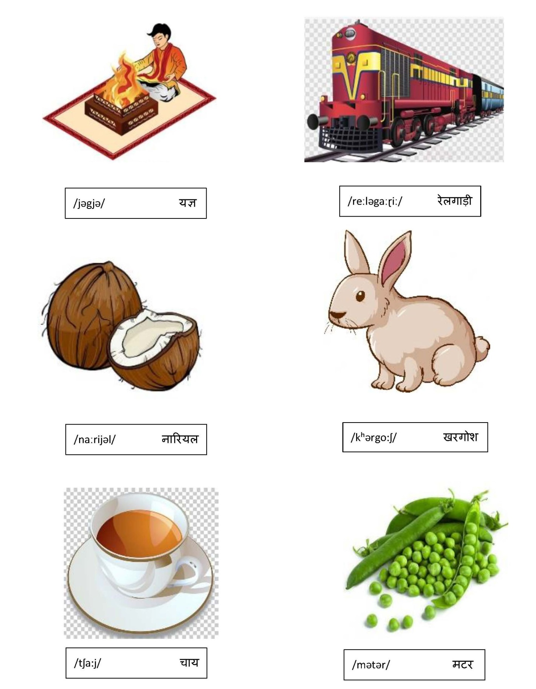
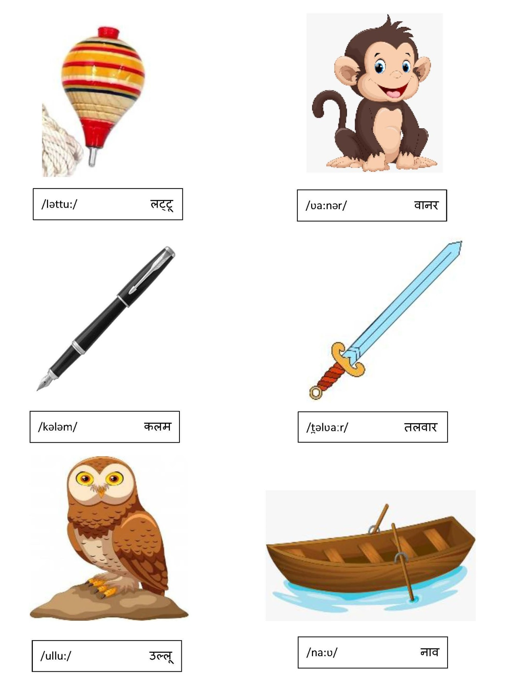
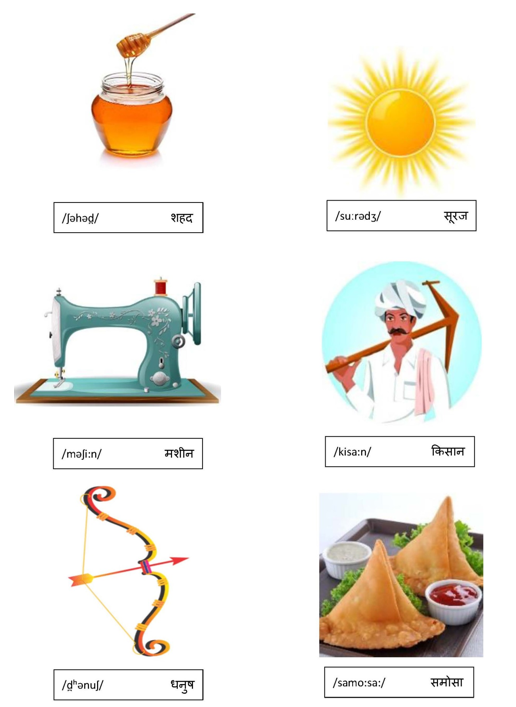
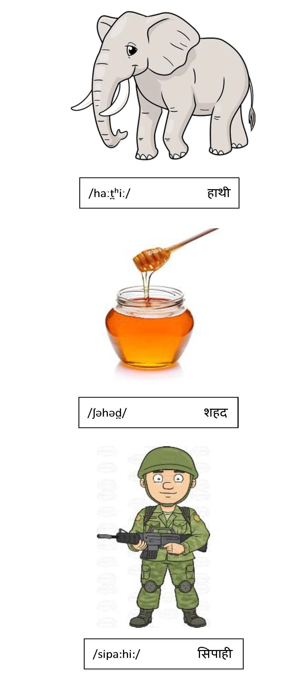
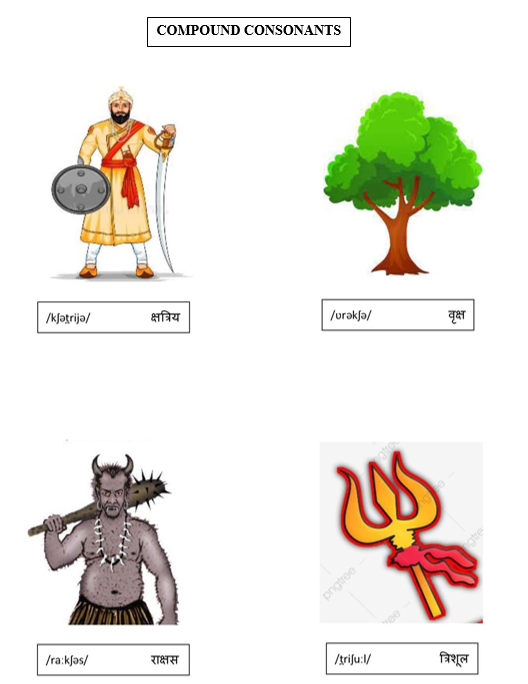
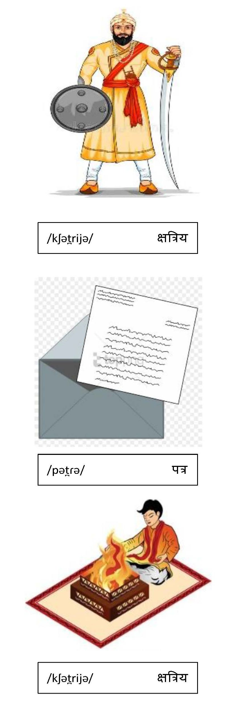
Conclusion
The current study aimed at constructing a ‘Revised Picture Articulation Test in Hindi’ to fill the current gaps in the assessment tools available for evaluating speech sound disorders in the Hindi-speaking population. For this purpose, 11 vowels, 29 consonants and 3 compound consonants of Hindi language were selected. A list of 115 familiar words was prepared with these phonemes in the initial, medial and final positions in words. The words prepared were highly familiar, picturable, meaningful and non- ambiguous. Attractive coloured pictures were selected to form the test material. The test was administered on 200 Hindi speaking typical children ranging from 4-8 years of age. The total number of children were divided into 4 age group: 4.0-4.11 years, 5.0-5.11 years, 6.0-6.11 years & 7.0-7.11 years, with equal number of children in each group and the female to male ratio was 1.17:1. The subjects were tested individually. The pictures were presented one after the other. The children were instructed to name the pictures, the responses were recorded on the recording sheet and the results were tabulated and subjected to statistical analysis. From the study, it was evident that the as the age increased the articulation scores also increased. All the vowels except /??/ were acquired in initial, medial and final position of words before 4 years of age in Hindi speaking typical children. Vowel /??/ was acquired in initial & final positions in words by 4 years of age whereas it was achieved in medial position by 5 years. However, the result findings do not correlate with the previous study done by Ruas in 1989 in Hindi language. The present study showed a delay in acquisition of consonants in Hindi and this can be attributed to the social, cultural and educational changes that have taken place in the recent past. Thus, it can be inferred that second language acquisition might have an effect on the acquisition pattern of first language (Hindi). The inclusion of compound consonants in the present study makes it more appealing and enhances the accuracy of assessments and enable appropriate intervention planning, thereby improving therapeutic outcomes. A. Clinical Implications The development of a revised Picture Articulation Test in Hindi contributes to the existing body of knowledge in speech-language pathology for the assessment and diagnosis of speech sound disorders. Using this test, a suitable treatment approach can also be indicated. It provides researchers, clinicians and educators with a standardized tool that can be used for research, documentation and cross-linguistic comparisons. This will facilitate the advancement of evidence-based practice in the field. B. Limitations 1) Not all selected phonemes are tested in all three positions in words. 2) Number of population is comparatively less. 3) The test does not have the provision for deep testing of individual phonemes. C. Future Directions 1) Development of revised Deep Test of Articulation in Hindi language. 2) Can be used for the research on co-articulatory effect of preceding and following sounds.
References
[1] American Speech- Language- Hearing Association Ad Hoc committee on service delivery in school (1993). IDEA and your caseload: A template for Eligibility and dismissal criteria for students ages 3 through 21, p. 14. (ASHA, 2003X). [2] Andrews, N., &. Fey, M. A. (1986). Analysis of the speech of phonologically impaired children in two sampling conditions. Language, speech and hearing services in schools, 17, 187- 198. [3] Arlt, P. & Goodban, T (1976). Articulation Norms used by Practicing Speech Language Pathologists in Oregon: Results of a survey. Journal of Speech and Hearing Disorders, XLV: 103-111. [4] Banik, A., & Barman, A. (1988). Screening test of Articulation and Discrimination in Bengali. Unpublished dissertation, university of Mysore, Mysore. [5] Bankson, N. W and Bernthal, J.E (1990). Quick screen of Phonology (QSP) Chicago: Riverside Press. [6] Babu, R. M., Rathna, N., and Bettagere, N. (1972). Test of Articulation in Kannada. Journal of All Institute of Speech and Hearing, 3, 64-79. [7] Bernthal, J. &. Bankson, N. (1978). Formal Screening Measures. Articulation and Phonological Disorders (Yd edition). New Jersey, Prentice Hall, 1997. [8] Bernthal, J. &. Bankson, N. (1979). Formal Screening Measures. Articulation and Phonological Disorders (3 edition). New Jersey: Prentice Hall, 1997. [9] Bernthal, J., Bankson, N. (1990). Formal Screening Measures. Articulation & Phonology Disorders (3rd edition). New Jersey. Prentice Hall, 1999. [10] Bernthal, J., Bankson, N. W., & Flipsen, P., Jr. (2017). Articulation and Phonological disorders: Speech sound disorders in children. New York, NY: Pearson. [11] Bleile, K. M. (1995). Manual of articulation and phonological disorders: Infancy through adulthood. San Diego, Calif: Singular Publishing Group. [12] Black, L. I., Vahratian, A., & Hoffman, H. J. (2015). Communication disorders and use of intervention services among children aged 3-17 years; United States, 2012 (NHS Data Brief No. 205). Hyattsville, MD: National Center for Health Statistics. [13] Compton, S. (1975). Articulation Assessment, Speech, Language and Hearing, Philadelphia: W. B. Saunders Company, 1982. [14] Darley, F. L. (1991). Collection of Data, Articulatory and Phonological Impairments- A Clinical Focus. Waengler: Clarion University. Library of\' Congress cataloguing in Publication Data. [15] Dewey, D., & Tupper, D. E. (Eds.). (2004). The science and practice of neuropsychology. Developmental motor disorders: A neuropsychological perspective. New York, NY, US: Guilford Press. [16] Dixit, R. P. (1963). The Segmental Phonemes of Contemporary Hindi. M. A. thesis, University of Texas, Austin. [17] Drumwright, A. (1972). Denver Articulation Examination. Denver: Ladoca Project and publishing Foundation. [18] Dubois, F. & Bernthal, J. E. (1978). A Comparison of Three Methods for obtaining Articulatory Responses. Journal of Speech and Hearing Disorders, 43, 295-305. [19] Dyson, A. T. & Robinson, T. W. (1987). The Effect of Phonological Analysis Procedure on Selection of Potential Remediation Targets. Language, Speech and Hearing Services in Schools, 18, 364 — 377 [20] D\'Souza, V. D., & Rao, T. S. (2001). Picture Articulation Test in Konkani. Unpublished Masters Dissertation. Bangalore University, Bangalore. [21] Edwards, J., & Beckman, M. E. (2008). Methodological questions in studying consonant acquisition. Clinical linguistics & phonetics, 22(12), 937-956. [22] Fabus. R & Gironda. F. (2011). Assessment of Articulation and Phonological Disorders. [23] Fase, W., Jaspaert, K., & Kroon, S. (1992). Maintenance and loss of minority languages: Introductory remarks. Maintenance and loss of minority languages, (1), 3-13. [24] Fisher. H. B. Logeman, J. A. (1971). Articulation Assessment. Speech, Language and Hearing. Philadelphia: W. B. Saunders Company, 1982. [25] Fluharty, N. (1978). Fluharty Preschool Speech and Language Screening Test. Boston, MA: Teaching Resource Corporation. [26] Healy, T. J. &. Madison, C. L. (1987). Articulation Error Migration: A comparison of Single Word and Connected Speech Samples. Journal of Communication Disorders, 20, 129- 136. [27] Hodson, B. (1980). Articulation. Philadelphia: W. B. Saunders Company. [28] Irwin. (1972). A Compact Picture Articulation Test. Journal of Speech and Hearing Disorders, 27 (1) 36-39. [29] Irwin, R., West, J. & Trombetta, M. (1966). Effectiveness of Speech Therapy for second Grade Children with Misarticulations: Predictive Factors, Exceptional Children, 471-479. [30] Ingram, D. (1976). Articulation Assessment. Speech, Language and Hearing. Philadelphia: W. B. Saunders Company, 1982. [31] Johnson, J., Winney, B. &. Pederson, O. (1980). Single Word Versus Connected Speech Articulation Testing. Language, Speech and Hearing Services in Schools, I l, 175- 179. [32] Kaufman, D., & Aronoff, M. (1991). Morphological disintegration and reconstruction in first language attrition. First language attrition, 175. [33] Kaur, R., & Rau, T. A. S. (2015). Descriptive Analyses of Phonological Development in Typically Developing Hindi-Speaking Children. Language in India, 15(5), 235-255. [34] Kenny, K., Prather, E., Mooney, M. & Jernzil, N. (1984). Comparisons among the Articulation Sampling Procedures with Preschool Children. Journal of Speech and Hearing, 27, 226-231. [35] Kim, M. J., Pae, S. Y., & Lee, S. E. (2005). The development of the \'Test of Articulation for Children\': Concurrent validity. Communication Sciences & Disorders, 10(1), 82-96. [36] Kim, Y. T., Park, H., Kang, J. K., Kim, J. A., Shin, M. J., Kim, S. J., & Ha, J. W. (2018). Validity and reliability analyses for the development of Urimal Test of Articulation and Phonology-2. Communication Sciences & Disorders, 23(4), 959-970. [37] Klein, H. B. (1984). Procedure for Maximising Phonological Information from Single Word Responses. Language, Speech and Hearing Services in Schools, 15, 267274. [38] Kouritzin, S. G. (1999). Face [t] s of first language loss. Routledge. [39] Manoj, P. (1998). A Photo Articulation test in Malayalam. Unpublished Masters Dissertation. University of Mysore. Mysore. [40] Markman, E. M.; J. L. Wasow, M. B. Hansen (2003). \"Use of The Mutual Exclusivity Assumption by Young Word Learners\". Cognitive Psychology 47 (3): 241-275. [41] Maya (1990). An articulatory test battery in Malayalam. Dissertation Abstracts, 2, 179-180. [42] McLeod, S., & Crowe, K. (2018). Children\'s Consonant Acquisition in 27 Languages: A Cross-Linguistic Review. American Journal of Speech-Language Pathology. [43] Mc Donald, E. (1976). Communication Disorder- An Introduction by Van Hattun, R.J New York: Mammalian Publishing Company. Inc. [44] Neenu Sobhan., & Sreedevi, N. (2012). Revalidation of norms for Malayalam Diagnostic Articulation Test (3-4 Years) Student research at AIISH Volume 1X: 2010-11, Part B, 124-132. [45] Nicolosi, L Harrylmen, E & Krescheck, J (1996). Terminology of Communication Disorders: Speech-Language- Hearing (4th ed). Baltimore: Williams and Willikins. [46] c: JRCRS. 2017; 5 (2): 89-93. Journal Riphah College of Rehabilitation Sciences, 5(2), 89-93. [47] Ohala, M. (1983). Aspects of Hindi Phonology. Delhi: Motilal Banarsidass. [48] Ohala, M. (1991). Phonological areal features of some Indo-Aryan languages. Language Science 13„ 107-24. [49] Ohala, M. and Ohala, J. J. (1993). Phonetic universals and Hindi segment durations. Proceedings of the Second International Conference on Spoken Language Processing, 831-4. Edmonton: University of Alberta. [50] Padmaja, B. (1989). Telugu Articulation Test. Unpublished Masters Dissertation. University of Mysore, Mysore. [51] Pandit, R. (1992). Picture Articulation Test in Hindi. Unpublished work at PANDIT New Delhi: Department of ENT, All India Institute of Medical Education and Sciences. [52] Parinitha, P. S., & Prabhu, S. (2010). Picture Articulation Test in Tulu. Unpublished Masters Dissertation, Mangalore University, Mangalore. [53] Paul, R. (2001). Language disorders from infancy through adolescence: Assessment & intervention. St. Louis: Mosby. [54] Poole, I. (1934). Genetic Development of Consonant sounds in speech, Elementary English Review, II, 159-161. [55] Prabhu, S., Meghana, A.K., Subhash, D., and Rao, T.A (2015). Development of screening Articulation Test Common to Multiple languages. Journal of Nursing and Health Science. 4, 36-40. [56] Prathima, S. (2009). Articulatory acquisition in Kannada speaking urban Children 3-4 years. Masters Dissertation University of Mysore, Mysore. [57] Prather, E.M., Hedrick, D.L. & Kurn, C.A (1975). Articulation Norms used by survey. Practicing Speech-Language Pathologists in Oregon: Results of a Journal of Speech and Hearing Disorders, XLV:103-111. [58] Pyata, R., & Banik, A. (2016). Phonological Development Profile in Typically Developing Hindi Speaking Children. Language in India, 16:3. [59] Randolph CC (2017) Overview of Phonological Disorders: The Language Based Speech Sound Disorder. Journal of Phonetics & Audiology 3(1)000128. [60] Shamiya, S., & Kumaraswamy S. (2019). Picture Articulation Test in Kashmiri. Unpublished Masters Dissertation, Mangalore University, Mangalore. [61] Shriberg, L. D. &. Kent, R. (2003). Appraisal: Collection of Data. Articulation and Phonological Impairments — A Clinical Focus (Yd edition). Jacquiline Bauman: Waengler. [62] Simmons, R., Blodgett, E. &. Miller, V. (1983). Assessment of Phonological Disorders in Conversation and Single Word Picture Naming. Paper Presented at Annual convention of American- Speech-Language- Hearing association. [63] Smith, Hand, Freilinger, Bernthal and Bird (1990). The Iowa Articulation Norms. Project and Its Nebraska Replication. Journal of Speech and Hearing disorders, 55, 779-798. [64] Snow, K. &. Milsen, R. (1954). The influence of Oral Versus Pictorial Presentation upon Articulation Testing Results. Journal of Speech and Hearing Disorders, Monograph, (4): 24- 36. [65] Somanna, C. G., & Varghese A. (2007). Picture Articulation Test in Coorgi. Unpublished Masters Dissertation, Mangalore University, Mangalore. [66] Templin, M.C (1957). Articulation Norms used by practicing speech- language Pathologists in Oregon: Results of a Survey. Journal of Speech and Hearing Disorders, XLV: 103-111. [67] Templin, M.C & Darley, F.L (1969). Templin Darley Test of Articulation. Iowa City: Bureau of education research and service, university of Iowa. [68] Tyler, A.A., & Macrae, T. (2010). Stimulability: Relationships to other characteristics of children\'s phonological systems. Clinical Linguistics & Phonetics, 24 (4-5), 300-310. [69] Usha, D., & Karanth, P. (1986). Test of articulation in Tamil. Unpublished Masters Dissertation, University of Mysore, Mysore. [70] Van Riper C & Erikson, R. (1969). A predictive articulation screening. Journal of speech and hearing disorders 34,214-219. [71] Weybright, G. (1976). Articulation Norms Used by Practicing Speech- Language Pathologists in Oregon. Journal of Speech and Hearing Disorders, XLV: 103-111. [72] Wellman, Case, I., Mengert, I & Bradburg, D. (1931). Articulation Norms Used by Practicing Speech- Language pathologists in Oregon. Journal of Speech and Hearing Disorders, XLV: 103-111.
Copyright
Copyright © 2023 Himani Bansal, Dr. Satish Kumaraswamy. This is an open access article distributed under the Creative Commons Attribution License, which permits unrestricted use, distribution, and reproduction in any medium, provided the original work is properly cited.

Download Paper
Paper Id : IJRASET55148
Publish Date : 2023-08-02
ISSN : 2321-9653
Publisher Name : IJRASET
DOI Link : Click Here
 Submit Paper Online
Submit Paper Online

